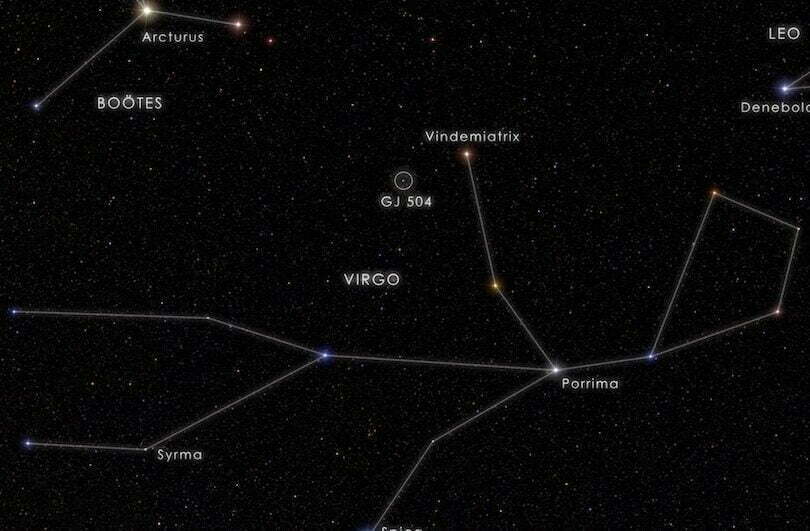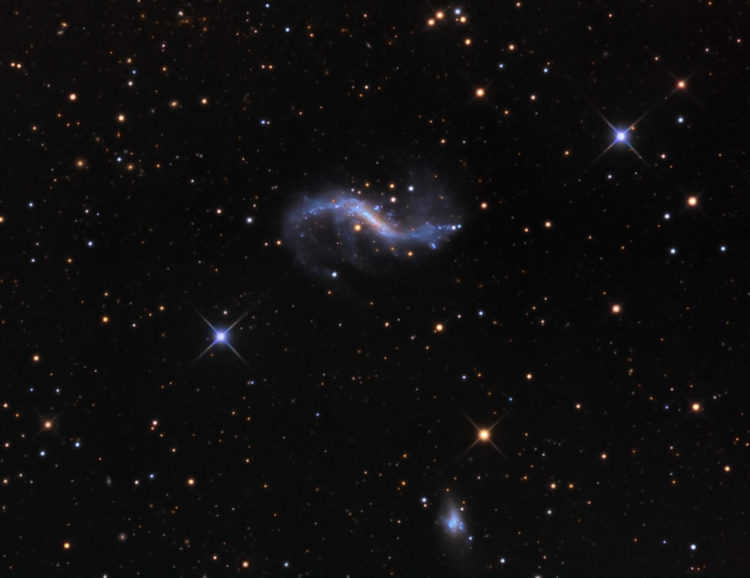
- Constellations
"When it comes to the Virgo constellation, the stars in the head area, as well as the star at the end of the southern wing, have a striking resemblance to Mercury and, to a lesser extent, to Mars; the other bright stars in the wing and those in the belt have similar appearances to Mercury and partly to Venus; a large star in the northern wing, known as Vindemiator, also behaves like Saturn and Mercury; the so-called Spica behaves like Venus and, to a lesser extent, Mars; the stars at the tips of the toes and plume resemble Mercury and, to a lesser extent, Mars…. "
Claudius Ptolemy – On the Influence of the Stars – "A Mathematical Treatise in Four Parts"
History of Research
Virgo, also known as Latin Virgo, is a zodiacal constellation located between Leo and Libra along the equator. In modern times, the autumnal equinox is situated within the Virgo constellation.
Virgo has a long history and has been recognized for over 4500 years. It was documented in the star atlas created by the ancient Greek astronomer Hipparchus in the 2nd century B.C. and also in the renowned Almagest by the Alexandrian scientist Claudius Ptolemy in the 2nd century A.D. The composition of the constellation has remained largely unchanged throughout history.
Virgo is home to a significant cluster of galaxies, which is considered one of the most powerful. According to the notable French astronomer J. Vaucouleur and other astronomers, this cluster serves as the center of the Supergalaxy, where stellar systems play the role of stars.
Summary
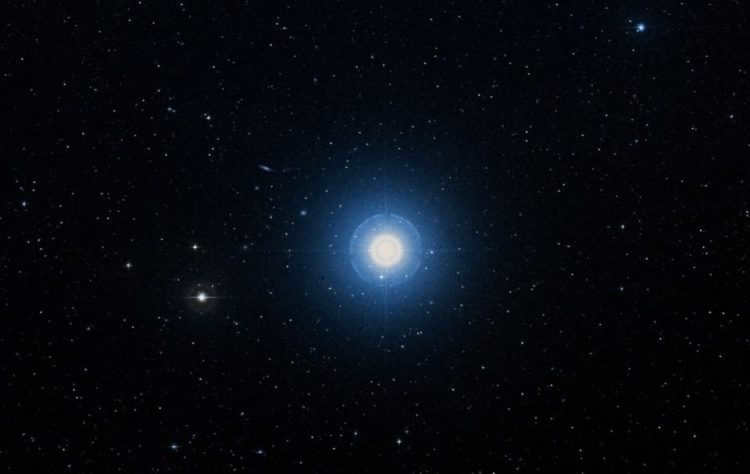
Detailed description
Virgo is one of the 12 constellations of the zodiac. It is situated along the ecliptic. From September 16 to October 30, the Sun passes through this group of stars, and it crosses the autumnal equinox on September 22. The largest constellation out of the 88 is Hydra, with Virgo taking a respectable second place. Leo borders it to the west, while Libra borders it to the east. The brightest star in Virgo is Spica, which is located in the eastern part of a massive star cluster.
Spica holds the distinction of being the 15th brightest star in the night sky.
This brilliant constellation is situated at a distance of 260 light years away from our planet. It was thanks to Spica that Hipparchus first discovered the phenomenon of the precession of the equinoxes. Nicolaus Copernicus also dedicated a significant amount of time to observing this remarkable star. The blue giant has a mass that is 10 times greater than that of the Sun, and its radius is 7 times larger. In terms of luminosity, it shines 12 thousand times brighter than our Sun. The variable star has a mass that is 7 times greater than that of the Sun, and its radius is correspondingly 3.6 times larger. The word “spica” translates from Latin as “spike”.
Additional prominent stars include Beta Virgo, Gamma Virgo, Delta Virgo, and Epsilon Virgo. The less bright stars in this constellation are Zeta Virgo, Eta Virgo, and Utah Virgo. One notable star in close proximity to Earth is Gamma Virgo, also known as Porrima. It is situated approximately 32 light-years away and is classified as a binary star. Both stars in the system are currently in the Main Sequence and possess twice the mass of our sun. Due to its close proximity to the ecliptic, Porrima is occasionally obscured by the Moon and on rare occasions, it can be occulted by planets within our solar system.
There are several remarkable and captivating entities worth observing in the constellation of Virgo:
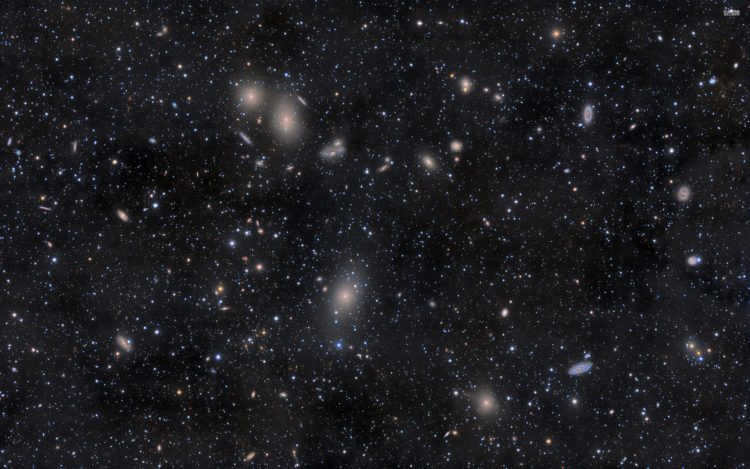
The Virgo galaxy cluster is known to be the nearest and largest collection of galaxies that are physically connected to the Local Group, which consists of our own galaxy, the Milky Way. This particular cluster of galaxies exerts gravitational forces on all the galaxies in its vicinity due to its immense mass. As a result, many galaxies that were not previously part of the Virgo cluster have now been drawn into it. The picture above shows a massive elliptical galaxy located near the center, known as M 87.
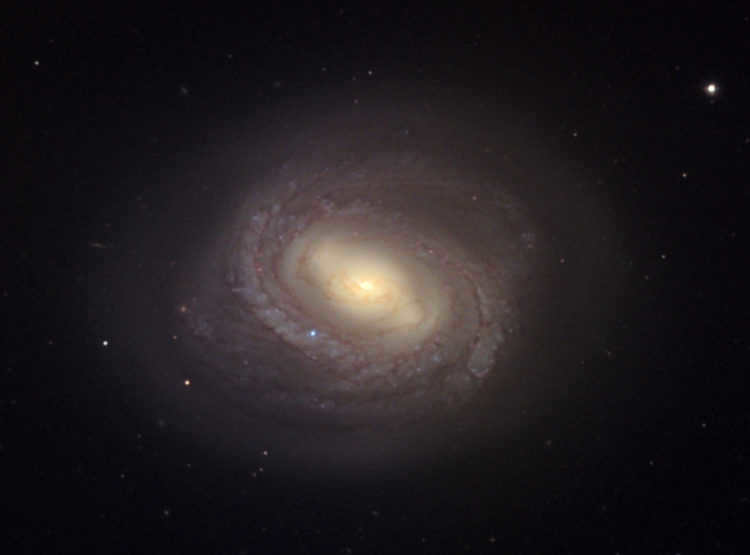
M 49 is an elliptical galaxy of the E4 type. It is a member of the Virgo galaxy cluster and is located at a distance of 60 million light-years. The major axis of the galaxy’s elliptical shape measures approximately 160 thousand light-years. With a brightness of 8.4 m, this galaxy can be observed using a amateur telescope.
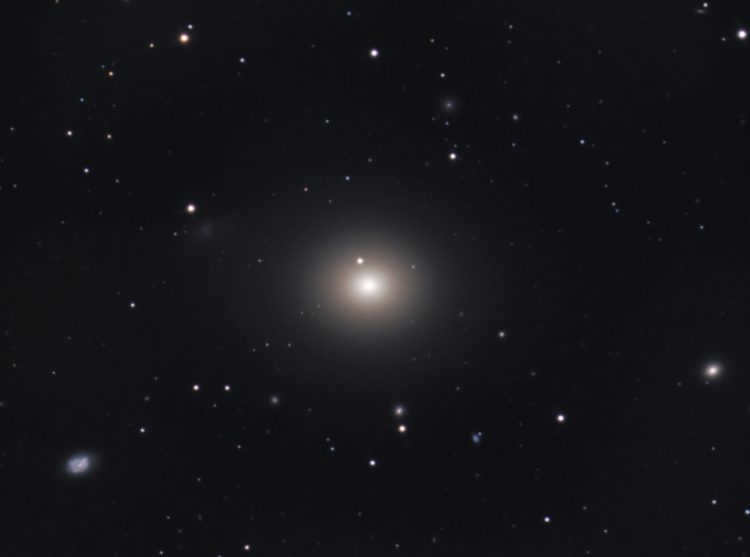
M 58 is classified as a spiral galaxy with a SBc-type junction. It has a magnitude of 9.7 m. Supernovae eruptions were observed in this galaxy in both 1988 and 1989. When observing this galaxy with an amateur telescope, only the bright, saturated nucleus can be seen as a prominent spot. However, with a telescope aperture of at least 150 mm, the arms of the galaxy can be observed.
Unfortunately, I was unable to find a higher quality image of this elliptical galaxy of E5 type. It is worth noting that M 59 is one of the largest elliptical galaxies, with a linear size of approximately 90,000 light years. Despite its distance, astronomers have managed to identify around 2 thousand globular star clusters within this galaxy. The galaxy has a magnitude of 9.6 m.
5-6. Galaxies M 60 (NGC 4649) and NGC 4647
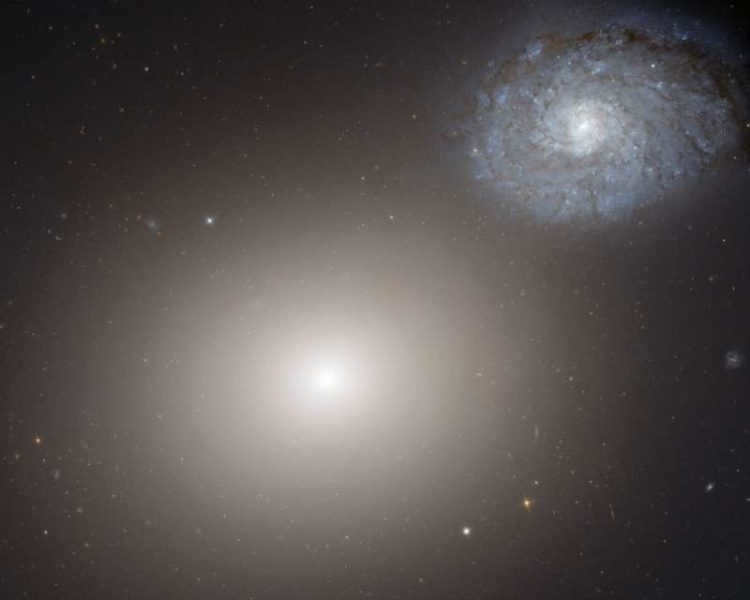
M 60 is classified as an E2 type elliptical galaxy. It is situated in close proximity to the neighboring galaxy M 59. Both can be observed simultaneously when using low magnifications on a telescope. M 60 is located approximately 60 million light-years away from the Sun and has linear dimensions equivalent to about 120 thousand light-years along its major elliptical axis. It has a magnitude of 8.8.
Adjacent to M 60 is the spiral galaxy NGC 4647. To observe NGC 4647, a professional-grade telescope will be required. It has a magnitude of 11.4.
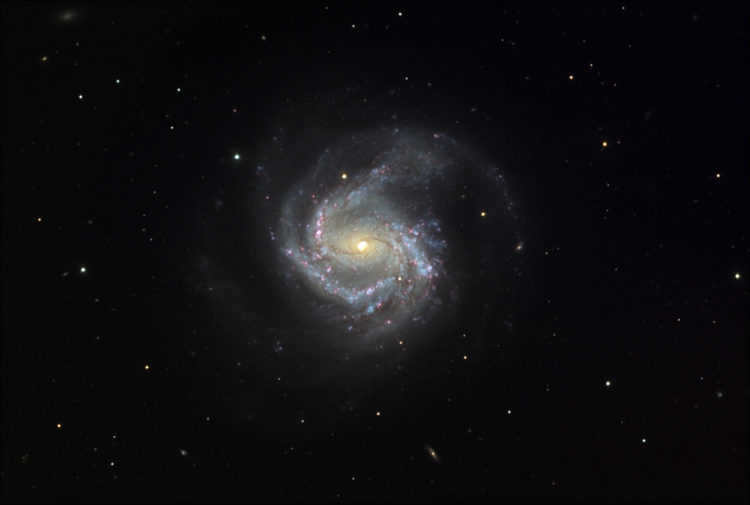
The Virgo cluster includes a spiral galaxy known as M 61, which has a junction of the SBbc type. This galaxy is similar in size to our Milky Way galaxy. Its brightness is measured at 9.7 m (some sources claim 9.3 m). When observed through a small amateur telescope, it appears as a hazy spot that becomes brighter towards the center, without any discernible outlines or branches.
M 61 is positioned separately from the cluster of other galaxies, located at the bottom.
M 84 is an S0 type lenticular galaxy situated in the heart of the Virgo galaxy cluster. Research conducted on this galaxy has revealed the presence of two radio-emitting gas jets that are expelled from the core at high speeds. The Hubble telescope has conducted a thorough examination of this galaxy and discovered a remarkably massive entity located 26 light years away from the core, boasting a mass equivalent to roughly 300 million solar masses.
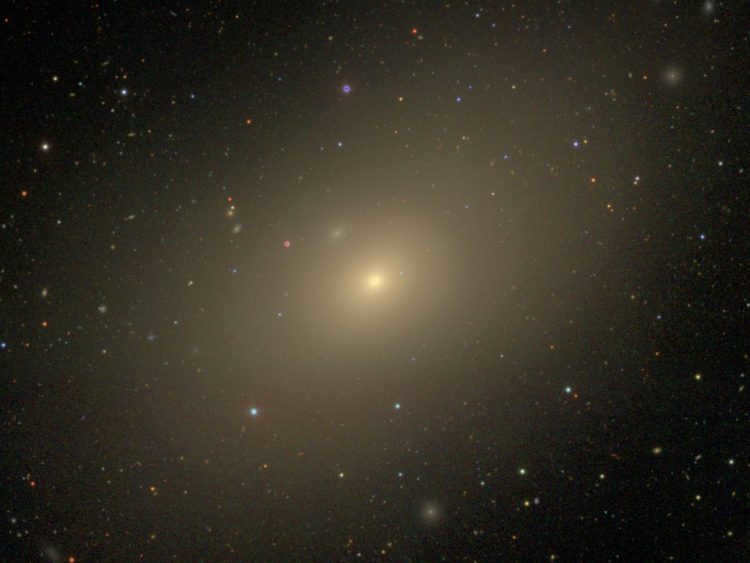
M 86 is classified as a lenticular galaxy of the S0 type. Among all the galaxies in the Virgo cluster, M 86 exhibits the highest blue shift, indicating that it is moving at the greatest velocity towards our own galaxy. It has a brightness of 8.9 m and when observed through a telescope, no further details can be discerned.
M 87 is an elliptical galaxy of the E1 type. Similar to galaxy M 84, it is situated in the central region of the Virgo cluster. M 87 is an exceptionally large galaxy, often referred to as Virgo A. Its linear diameter spans approximately 120,000 light years, and it is located 56 million light years away from our position.
The core of Galaxy M87 contains a massive dark object that emits radio and X-ray radiation, according to detailed observations made by the Hubble telescope. This object, which has a mass equivalent to 2-3 billion solar masses, is surrounded by a rapidly rotating gas disk and spans a distance of 60 light-years.
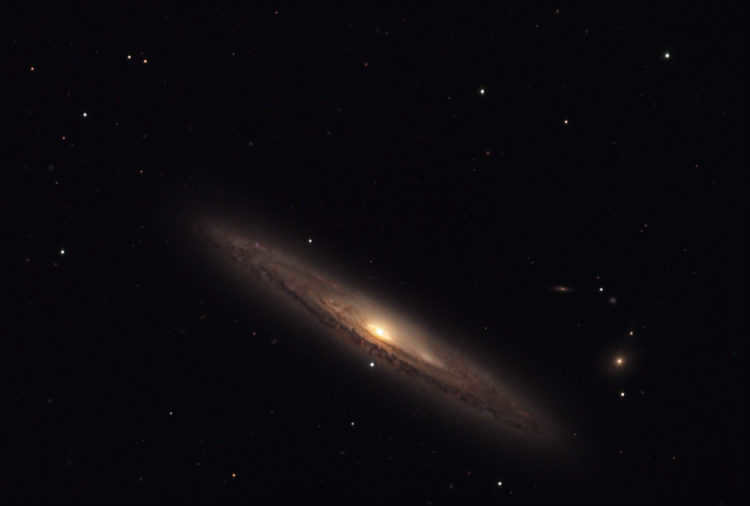
NGC 4216 is classified as a spiral galaxy with an SBb-type junction. Charles Messier initially overlooked this galaxy within the Virgo cluster, but it was later observed by William Herschel through his telescope. It is fascinating to note the multitude of additional galaxies visible in the background. The galaxy has a magnitude of 10.3 m.
This unassuming elliptical galaxy, NGC 4261, belongs to the E2 type and is located not far from the spiral galaxy M 61. It is also situated away from the primary group of galaxies within the Virgo cluster. The Hubble telescope detected strong radio emissions and gas emissions emanating from the core of this galaxy. Its brightness is measured at 10.4 m.
13-14. Eyes galaxies or NGC 4435 and NGC 4438
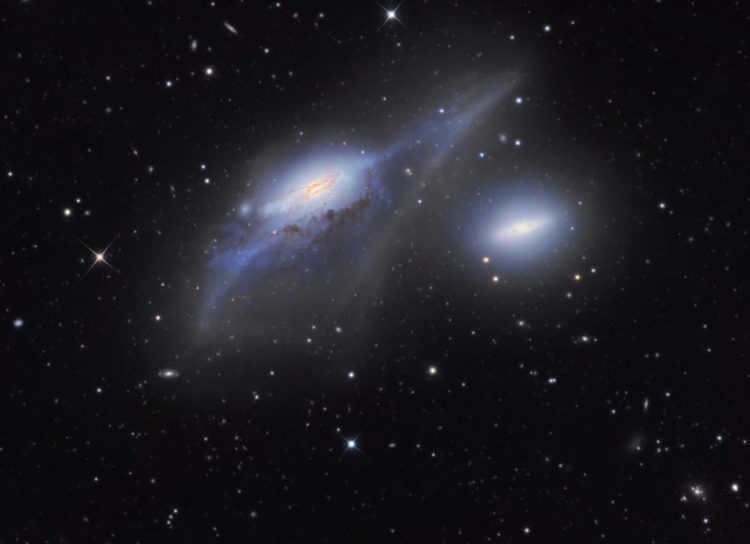
The two galaxies are known as the “Eyes” in international literature (Eyes Galaxies). Their combined apparent stellar magnitude is around 10.0 m, while individually their brightness reaches the 11th magnitude. These galaxies are situated at a distance of 52 million light years from our position. When observed through a telescope, both galaxies are visible within the eyepiece’s field of view.
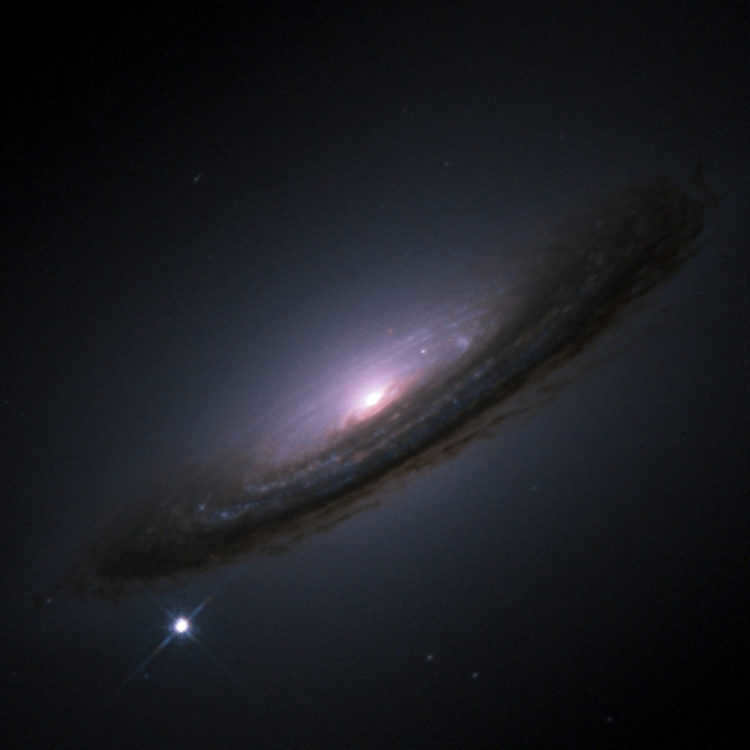
The SB0 type galaxy NGC 4526 is a remarkable lenticular galaxy with a magnitude of 9.6 m. Interestingly, in the “New General Catalog”, this galaxy is listed twice, with the designations 4526 and 4560. The reason for this duplication remains unknown. If you have any theories or knowledge about this phenomenon, please share in the comments.
Located at the heart of NGC 4526 is an incredibly massive black hole, weighing over 400 million times the mass of our Sun.
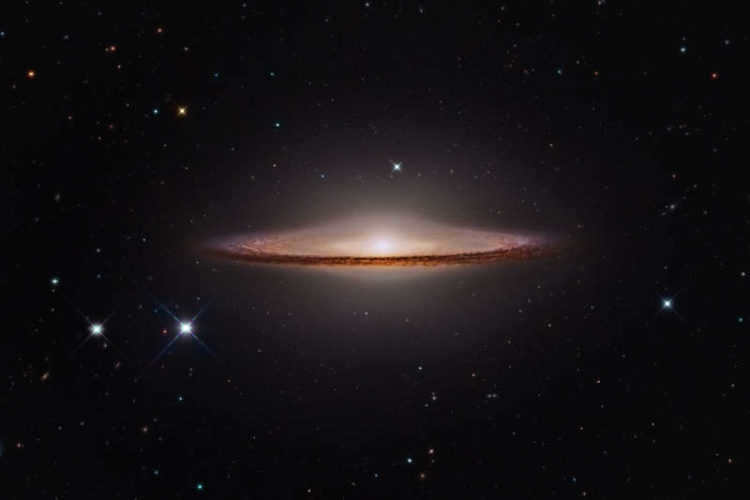
Who among us hasn’t heard of the Sombrero galaxy before? It’s quite famous, much like the Andromeda Nebula in the Andromeda constellation. It’s mentioned in various reference books, encyclopedias, and astronomical magazines; you can even find it on their covers. The Sombrero galaxy is truly a sight to behold!
M 104 – is a spiral galaxy of the Sa type. Its unique shape and appearance make it easily distinguishable from other galaxies. The dark dust disk in the galaxy’s central plane is clearly visible. Modern calculations estimate that this star system contains several hundred globular star clusters. The brightness of the Sombrero galaxy is 8.1 m.
NGC 4517 Galaxy
Galaxy NGC 4527
It is agreed that at first glance, the galaxy bears a striking resemblance to the Andromeda Nebula. This is a belief shared by astronomers and scientists alike. However, NGC 4527 sets itself apart from the Andromeda Nebula due to the presence of active star formation. Additionally, a supermassive black hole, weighing in at 2.5 billion solar masses, has been discovered at its core. The galaxy boasts a brightness of 10.4 m (although some sources downgrade it to a stellar magnitude of 11).
How to locate the constellation?
The best time to observe Virgo is in early spring, specifically in March and April, when it moves towards the southern part of the horizon. Because of its vast size, the Sun remains in Virgo for over a month, from September 16th to October 30th. In ancient star maps, Virgo was depicted as a young maiden holding an ear of wheat in her right hand. However, not everyone can identify this figure among the scattered stars. Nevertheless, locating the Virgo constellation in the night sky is not a difficult task. It contains a first magnitude star that emits bright light, making it easy to spot Virgo among other constellations.
To find the constellation, people in the Northern Hemisphere need to first locate the Bucket within the Big Dipper constellation. From there, they can draw an imaginary line downward from the handle. Along this line, they will encounter the orange star Arcturus from the Volopassus constellation, and continuing on, they will come across a blue-white star – this is Spica, the brightest star in Aquarius. To confirm that they have found the correct constellation, they should look for the small square on the right side, which represents the Raven constellation.
We have previously discussed that Virgo is the second largest constellation among other celestial bodies. It is not surprising, as this constellation covers a significant portion of the night sky, accounting for one-third of its total area. To be exact, it spans across 1295 square degrees. Under favorable conditions, one can observe 171 stars from this zodiacal constellation with the naked eye. While it is impractical to describe each individual star, we will highlight some of the most prominent ones.
Legend
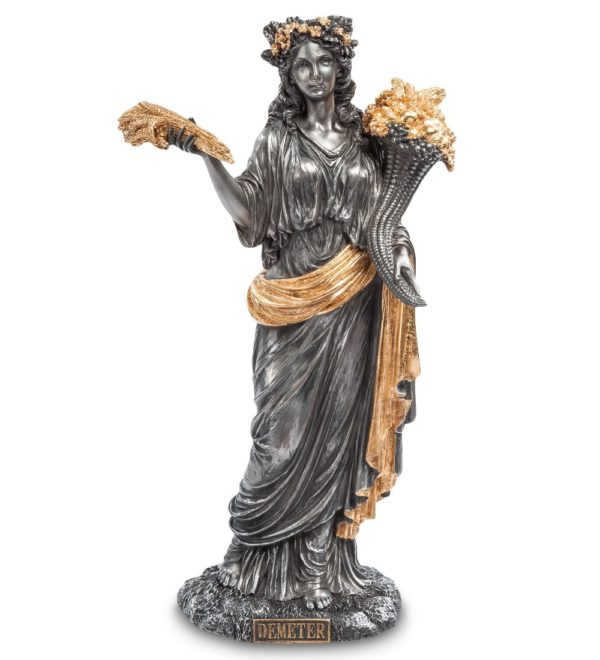
In Greek mythology, Demeter, the goddess of fertility and agriculture, personifies the constellation Virgo. It is said that she taught people how to cultivate the Earth, and without her life-giving power, the land would become a barren desert.
Demeter had a daughter named Persephone, who was known for her beauty and grace. Persephone’s father was Zeus, the god of thunder.
Persephone spent her days playing with her friends, the Oceanides, in the lush Nisei valley. Like a butterfly, she would flit from flower to flower, gathering cornflowers and violets. She would weave them into beautiful wreaths and decorate herself and her friends with them. The laughter and singing of Persephone and the Oceanides filled the valley, and even the fiercest beasts were enchanted by their joy.
Time passed swiftly. Persephone blossomed into an even more exquisite young woman, and the laughter and melodies of her companions grew even more vibrant. Little did she know that her days of basking in Helios’ radiant rays were numbered. Her formidable father, Zeus, made a solemn pledge to wed his beloved daughter to his brother Hades, the sovereign of the subterranean realm of darkness. There, she would dwell amidst perpetual gloom and the soundless echoes of lost souls, forever untouched by the warm embrace of sunlight.
When the time came, Hades took Persephone for himself. One fateful day, while she was playing with the Oceanids, Hades caught sight of Persephone and devised a plan to abduct her. He implored Gaea, the goddess of the Earth, to grow a flower of extraordinary beauty. Gaea agreed and produced a flower with such exquisite petals and an enchanting fragrance unlike anything ever seen before. Persephone noticed the flower and reached out to pluck it, but as soon as she leaned over, the ground beneath her feet split open. Hades emerged on a chariot pulled by black horses, snatched Persephone, and vanished into the unfathomable depths of the earth in an instant. The Oceanids were oblivious to Persephone’s disappearance, as everything unfolded so swiftly. The only thing they heard was a cry that echoed through the depths of the sea and the distant peaks of Olympus. Demeter, the goddess of the harvest, immediately rushed to the Nisean valley but found no trace of her daughter. Frightened, the Oceanids scattered and sought refuge with their father, the wise Oceanus. Demeter was consumed by grief, donning a long black robe and shedding tears as she embarked on a quest to find her daughter. However, she found no leads or clues. It was only on the tenth day that she learned from the radiant Helios that the somber Hades had taken Persephone to his realm of shadows.
The goddess Demeter was filled with even greater sorrow. Tears streamed down her cheeks. The entire world seemed to turn to ice. The leaves dropped from the trees and the wind whispered through the naked branches. The flowers withered, and the fertile fields transformed into a barren wasteland. Hunger gripped the land, and mournful cries echoed everywhere. Yet, none of this affected the goddess Demeter. Her thoughts were solely focused on her daughter. With a heavy heart, she embarked on a journey and arrived at the city of Eleusis. There, near the city walls, by the olive tree, she seated herself on the “stone of sorrow” next to the “well of maidens.” She sat there for a long time. The king of Eleusis’ daughters noticed her and brought her to their father’s palace. However, even in the palace, she remained consumed by grief and desolation.

Zeus’s expression turned sour upon hearing Irida relay Demeter’s response. He promptly summoned Hermes and issued a command for him to journey to the realm of Hades and deliver a message, urging him to release Persephone and allow her to reunite with her mother.
Hades was unable to resist doing Zeus’ bidding. He agreed to release Persephone, but before they parted, he held her tightly and made her consume a single pomegranate seed – a symbol of the unbreakable bond of marriage. From that moment on, Persephone could never forget Hades. Accompanied by Hermes, she sat in a chariot and was carried across the unfathomable depths of the underworld by winged horses. In an instant, they arrived in Eleusinus and halted in front of Demeter, who was frozen in anguish. Demeter was startled by the thundering hooves of the horses and lifted her head. When she saw her daughter, she was overcome with joy, embraced her, and together they ascended to Olympus. There, Zeus decreed Persephone’s fate: she would spend two-thirds of the year on earth, with her mother, and one-third would be dedicated to her husband Hades in the underworld.
Filled with joy that her daughter was by her side, Demeter cast her gaze upon the Earth. Her benevolent powers restored life and fertility to all things on Earth. The forests transformed into lush greenery, vibrant flowers blossomed in the meadows, melodious birds resumed their cheerful songs, and expansive fields turned a golden hue from the bountiful harvest. Once again, a jubilant occasion had arrived on Earth. Herds of cows, bulls, sheep, and goats grazed upon the verdant meadows and sought refuge in the shady forests, resembling immense white clouds. People lived in a state of happiness and joy once more. However, the time had come for Persephone to return to the depths of Hades in the underworld. Once again, Demeter was consumed by sorrow. The leaves on the trees turned a golden yellow and were stripped away by the cold winds. The grass withered, the flowers wilted, the birds ceased their songs, and only the eerie cawing of crows could be heard. Blizzards and snowstorms enveloped the Earth in a frigid embrace. Life seemed to slumber while Demeter mourned the fate of her daughter. Yet, Persephone returned to her mother, and the goddess once again bestowed the Earth with her life-giving power. The meadows and trees began to flourish with vibrant greenery, flowers bloomed in abundance, birds sang their melodious tunes, and Helios showered the Earth with golden rays. The fields transformed into a golden hue, the harvest became plentiful, and the songs of the reapers echoed far across the fields. Demeter, the goddess of fertility, generously bestowed her gifts upon the Earth, blessed the toil of farmers, and rewarded them with abundant fruits.
As soon as the Virgo constellation became visible in the night sky, observers immediately associated it with the majestic goddess Demeter. In their eyes, she was depicted holding mature ears of wheat and radiating pure happiness because her beloved daughter Persephone had returned to her side once more. This celestial sighting signaled the start of preparations for the upcoming harvest, with the hope that Demeter would bestow abundant blessings upon their diligent efforts.
Video
Legend has it that once a person beholds the splendor of the stars, solitude becomes a thing of the past. Accompanying this individual is a steadfast belief in the power of miracles, no matter how small. The veracity of this claim is difficult to ascertain, but one cannot deny the timeless allure of the stars, which have illuminated the night sky for countless millennia, instilling hope in humanity. To some, these celestial luminaries embody the spirits of the departed, while others view them as beacons of a potential intelligent civilization. For yet others, the stars serve as navigational guides, pointing the way to the right path.
This constellation has a long history. It was one of the star clusters included in Claudius Ptolemy’s “Almagest” – the first atlas of constellations. In the book, the Virgin was portrayed holding an ear of wheat in her right hand. However, in reality, only those with a vivid imagination can actually see this image in the night sky.
Legend about the origin of the constellation
It is possible that the ancient imagination attributed a particular image to the constellation because the stars that form it started shining in the sky during the harvest season. In various ancient civilizations, the Virgin symbolized the goddess of fertility. In ancient Greece, for instance, this goddess was known as Demeter, who granted people the ability to cultivate the land and gather abundant harvests. Without her life-giving power and rainfall, the surroundings would have transformed into a barren desert.
Once upon a time, Demeter and Zeus were gifted with a beautiful daughter. They named her Persephone. Since she was a little girl, she adored playing with the sunlight, crafting flower wreaths, and adorning herself and her companions, the Oceanides. She grew up to be cheerful, kind, and carefree, blossoming with each passing day. Demeter couldn’t have been happier with Persephone’s joy, and her happiness spread throughout the fields and gardens, resulting in bountiful harvests.
Little did Demeter know that at the time of Persephone’s birth, Zeus had secretly arranged her engagement to Hades, the ruler of the underworld. Now the time had come for the somber god to claim his bride. However, Hades realized that Demeter wouldn’t easily give up her daughter. He devised a cunning plan to get what he wanted.
Hades pleaded with Gaea, the Earth, to cultivate an exceptionally exquisite flower. Persephone caught sight of the blossom and felt a strong desire to pluck it. The moment the young girl reached out to touch the brilliantly hued petals, the ground split open, and Hades emerged in his chariot. He seized Persephone and whisked her away.
The Ruler of the Underworld executed his actions so swiftly that none of the Oceanids observed anything amiss and were unable to discern the whereabouts of the fair maiden. However, Demeter heard her anguished cry. Hastening to the valley, the goddess discovered no trace of her beloved daughter.
Upon hearing this news, the goddess was filled with even greater sorrow. The people were enduring a devastating famine, and even their offerings to the gods were proving futile. Zeus understood that if Demeter continued to grieve, the entire human race would soon perish. With this in mind, the Thunderer beseeched Hades to allow Persephone to return to the surface.
The lord of the underworld could not deny the request of the supreme god, and thus he permitted his daughter to reunite with her mother. However, as a parting gift, he bestowed upon her a heartfelt embrace and a single pomegranate seed.
Witnessing Persephone, the goddess of fecundity was filled with immense joy and accompanied her to the revered Mount Olympus. It was there that they encountered Zeus, who logically deduced that since the young girl had consumed sustenance from the Underworld, she would not be able to permanently reside on the surface. As a result, Persephone will dwell on earth for the majority of the year, but for a span of three months, she must descend into the realm of shadows to reunite with her husband Hades.
And so it has remained, whenever Demeter is united with her daughter, the earth thrives and nourishes its inhabitants. However, when the girl returns to Hades, the divine mother mourns and winter descends upon the land.
The emergence of Virgo, the most expansive constellation within the zodiac, in the celestial expanse signifies Demeter’s jubilation at Persephone’s homecoming, indicating that it is an opportune time for the bountiful harvest.
Astrological entities found within the star grouping
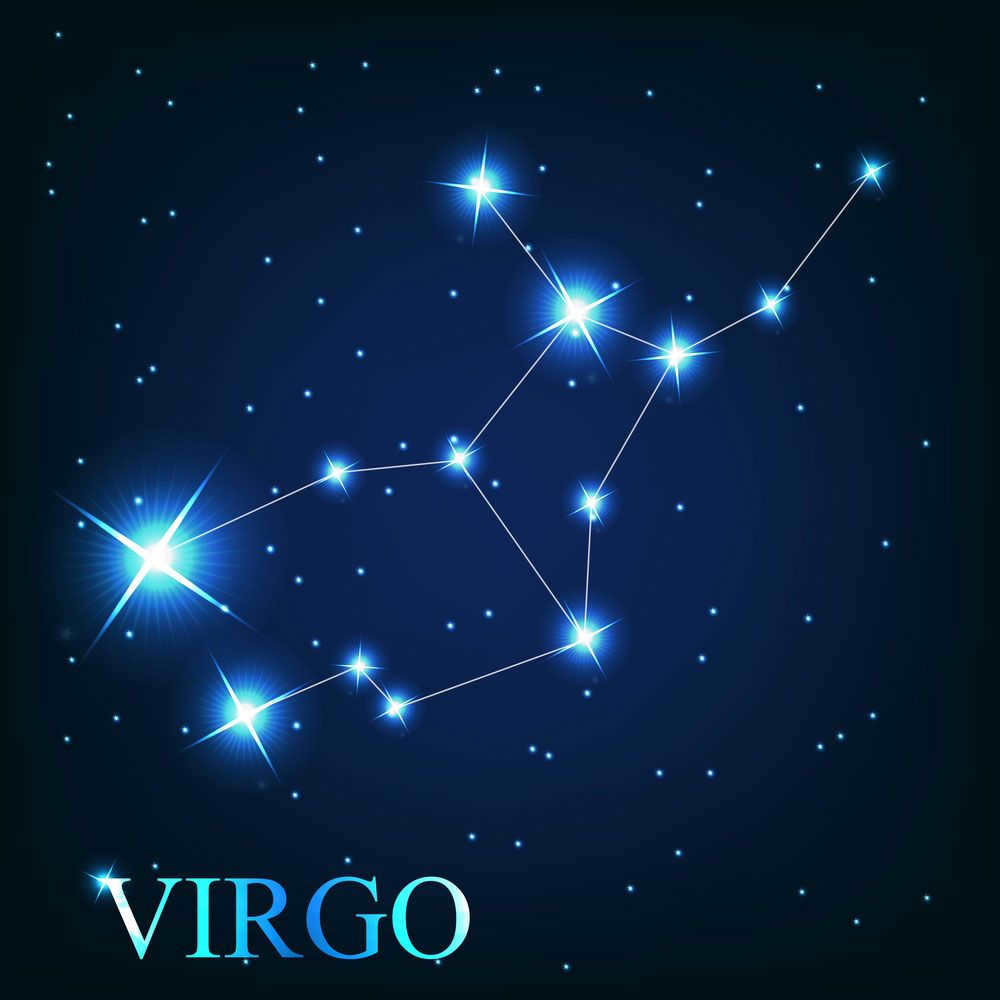
During a cloudless night, you can observe a range of 95 to 120 stars in the constellation of Virgo without the need for a telescope or any other optical aids. However, only a few of them are truly bright:
- Spica, also known as the “spike,” is the most prominent star in this constellation. Interestingly, its brightness varies between magnitudes of 0.92 and 1.4.
- Gamma Virgo, or Porrima (sometimes referred to as Ariche), is a binary star system. The smaller star orbits the larger one in an elongated path, completing a full revolution every 171 years. The current angular distance between the stars is merely 5 arcseconds, which led astronomers to mistakenly identify Porrima as a single star for a long time.
- Zabiyava is a star that shares many physical characteristics with our Sun.
Visually, these stars form what is known as the spring triangle, which can be seen in March-April, even in areas with light pollution. To locate this pattern, start with the “handle” of the Big Dipper and imagine its continuation. This will lead you to the star Arcturus, and then to Spica, which is Alpha Virgo. If you draw a line correctly, you will find a small square of stars to the right of Alpha, which is the constellation of the Raven.
In addition to stars, Virgo contains several other unique objects. One noteworthy example is the quasar 3C 273, which emits a tremendous amount of energy and is thought to be the core of a future galaxy. This phenomenon is recognized as the first of its kind by the scientific community.
Additionally, the upper right corner of the Virgo constellation offers a view of over 2,000 distant galaxies, as well as various Messier objects and star clusters.
Unique information about the star formation
- Virgo is the location of the present-day position of the autumnal equinox. When the Sun reaches this specific point in its yearly orbit, it marks the start of astronomical autumn (typically occurring on September 23-24).
- This constellation is the second largest among the 88 recognized celestial figures. It covers approximately one third of the entire sky.
Famous People Born Under the Sign of Virgo

Astrologers categorize individuals born between August 24 and September 23 as Virgos. These individuals are believed to possess a strong sense of accuracy and practicality, placing great importance on order in all aspects of their lives. They have a keen eye for detail and hold high standards for even the smallest things. From an early age, Virgos develop an idealistic view of the world, and they consciously strive to achieve this vision throughout their lives. Unfortunately, this image may not always align with societal expectations.
Virgos are not particularly interested in seeking attention or fame, but they highly value material wealth. Therefore, they may tolerate and even welcome close scrutiny if it leads to financial gain.
Notable individuals born under the sign of Virgo include:
- Politician Alexander Lukashenko
- Writer and novelist Leo Tolstoy
- Michael Jackson, the famous singer and dancer;
- Keanu Reeves, known for his acting and musical talent;
- Alexander Revva, a popular comedian and TV presenter;
- Alexander Ovechkin, a professional hockey player;
- Kostya Tszyu, a well-known boxer;
- Faina Ranevskaya, a talented actress;
- Yevgeny Leonov, a renowned actor;
- Alexander Rosenbaum, a composer and singer.
Virgo is a constellation found in the southern sky. The name “Virgo” comes from Latin and means “maiden” or “virgin”.
Virgo was one of the 12 constellations identified by Ptolemy in the 2nd century. It contains Spica, one of the brightest stars, and is also the location of the autumnal equinox (near Beta Virgo). It is one of two points (the other being in Pisces) where the celestial equator intersects with the ecliptic.
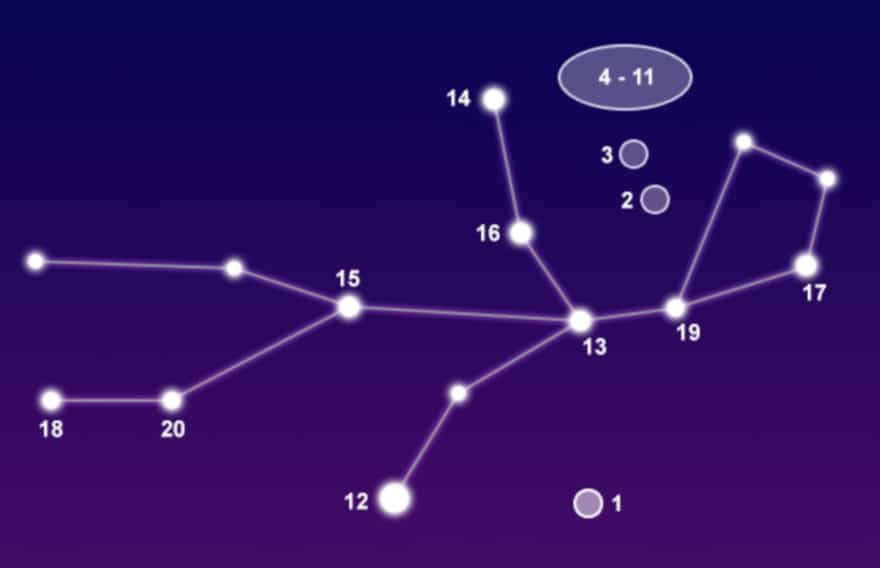
Windemiatrix is the official name for the star Epsilon Virgo.
Interesting Information, Location, and Chart
Virgo is the second-largest constellation, covering an area of 1,294 square degrees. It is located in the third quadrant of the southern hemisphere (SQ3) and can be observed at latitudes ranging from +80° to -80°. It shares borders with the constellations Veronica’s Hair, the Raven, the Cup, the Lion, Libra, the Magus, and the Serpent.
Includes 11 Messier entities and 20 stars that have planets. The most luminous of them is Spica (Alpha Virgo), which has an apparent visual magnitude of 0.98. There are two meteor streams associated with this constellation, namely the Virginids and the Mu Virginids. Virgo is classified as one of the Zodiac constellations, alongside Aries, Taurus, Gemini, Cancer, Leo, Libra, Scorpio, Sagittarius, Capricorn, Aquarius, and Pisces. Take a close look at the star chart to examine the arrangement of the Virgo constellation.
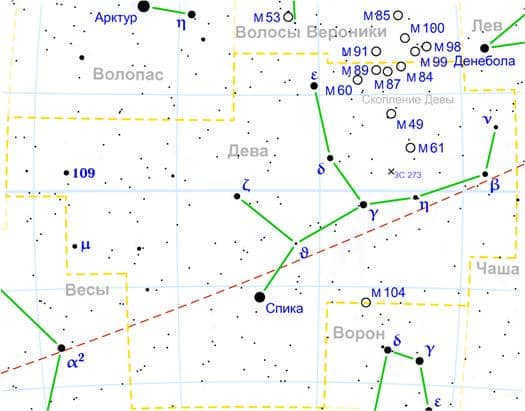
Legend
The constellation frequently observed is associated with the ancient Greek deity of justice, Dike. Dike was born to Zeus and Themis, and she is often portrayed with wings like an angel and holding a spike of wheat in her left hand, representing the star Spica. Virgo is positioned adjacent to Libra, which symbolizes justice. In some cases, she is also referred to as Astrea, the daughter of Astrea, the father of the stars, and Eos, the goddess of the dawn.
At times, the constellation Virgo is associated with various goddesses such as Demeter, the goddess of fertility, Atargatis, the Syrian goddess of fertility, and Erigon, who is the daughter of Icarius. According to another myth, Erigon, after the death of her father who is connected with Wolopas, took her own life by hanging herself. In addition, Erastothenes and Hyginus link this constellation to Tyuhe, the goddess of prosperity, who is often depicted holding a horn of plenty.
Notable celestial bodies
Discover the prominent stars within the zodiacal constellation Virgo, accompanied by comprehensive descriptions and unique attributes.
Spica (Alpha Virgo) – A fascinating binary star system where the components do not overshadow each other, but rather influence one another through gravitational forces. It possesses an apparent magnitude of 1.04, making it the brightest star in the Virgo constellation and the 15th brightest star in the entire night sky. Situated approximately 260 light-years away from our solar system, it stands as one of the closest massive double stars to us.
Spica is classified as a blue giant, specifically falling into the B1 III-IV and B2 V categories. The primary star occupies the intermediary stage between a subgiant and a giant, radiating a luminosity 12,100 times greater than that of the Sun. Its mass is substantial enough to eventually undergo a Type II supernova explosion.
The main-sequence star in question is a B2 V star, which is a rare example of the Struve-Sahade effect. This phenomenon occurs in double-line spectroscopic double stars, where the spectral lines weaken and shift towards the red end of the spectrum as they move away from the observer. However, in this particular case, the lines actually shift towards the blue end of the spectrum. Otto Struve first noticed this feature in 1937.
Similar to Beta Cephea, this star is also a variable star, with changes in brightness attributed to surface pulsations.
It is highly probable that Spica played a role in the discovery of the precession of the equinoxes by the Greek astronomer and mathematician Hipparchus in 127 B.C. The precession of the equinoxes refers to the gradual change in the Earth’s axis of rotation. Hipparchus measured the longitude of both Spica and Regulus and compared them with earlier data, revealing that Spica had moved 2 degrees relative to the fall equinox.
Nicolaus Copernicus, the first person to prove that the Earth was not the center of the universe, also utilized Spica. To locate it in the sky, one must track the trajectory of the handle of the Big Dipper to Arcturus and continue along the same path to Spica.
The term translates from Latin as “Virgo’s grain of wheat.”
Zaviyava (Beta Virgo) is a star (F9 V) situated 35.65 light-years away. Despite being labeled as “beta,” it is merely the fifth brightest star in the constellation.
Porrimae (Gamma Virgo) is a binary star with a visual magnitude of 2.74 and a distance of 38.1 light-years. The stars possess a spectral type of F0V and their visual magnitudes are: 3.65 and 3.56.
Alongside Beta, Eta, Delta, and Epsilon of Virgo, it forms the Barker asterism. Porrimae is the name of two goddesses associated with prophecy.
Delta Virgo is a red giant known as M3 III, with an apparent magnitude of 3.4, making it visible to the naked eye, and located 198 light years away. It has a mass 1.4 times that of the Sun, a radius 48 times larger, and is 468 times brighter. Its speed is estimated to be around 30 km/s.
This star exhibits variability in its brightness, ranging from 3.32 to 3.40. Furthermore, it is speculated that Delta Virgo may be part of a binary system, with an 11th magnitude dwarf located 80 arc seconds away. The potential orbital period of this system is believed to be around 200,000 years, but this hypothesis has yet to be confirmed.
The traditional name of this star, “Auva,” is derived from Arabic and translates to “barking (of dogs).”
Epsilon Virgo, on the other hand, is classified as a giant of type G8 III, with a visual magnitude of 2.286 and a distance of 109.6 light years. It shines with a brightness that is 77 times greater than that of the Sun. The name “Epsilon Virgo” originates from Latin and means “grape picker” or “grape harvest.”
Zeta Virgo is a main-sequence star (A3 V) that has a 3.376 apparent magnitude and is located 74.1 light-years away. It bears a resemblance to the Sun in terms of mass and radius. It can be observed in the sky without the need for binoculars.
This particular Virgo is a triple star system (A2 V) with a visual magnitude of 3.890 and a distance of 265 light years. The two inner stars are separated by 0.5 a.u. and revolve around each other with a period of 72 days. The third star is situated at a greater distance and orbits the pair every 13.1 years. These three stars are spaced closely together, making it impossible to distinguish them with a telescope.
The traditional name Zaniah derives from Arabic and signifies “angle”.
Iota Virgo is a star (F6 III) with an apparent magnitude of 2.44 and a distance of 69.8 light-years. The traditional name translates to “plume (garment)” from Arabic.
Mu Virgo is a yellow star (F2III) that has an apparent magnitude of 3.87 and a distance of 60.9 light years. The traditional name of this star translates from Arabic as “the paw of a dog that barks.”
70 Virgo is a yellow dwarf (G2.5Va) with a visual magnitude of 5.00 and a distance of 58.7 light-years. This star is thought to be transitioning into a subgiant because it is brighter than most stars of its spectral type. In 1996, an exoplanet was discovered orbiting this star.
Hy Virgo is a binary star system with an apparent magnitude of 4.652 and a distance of 294 light-years.
This star is an orange giant (K2 III) that is twice the mass of the sun, 23 times larger in radius, and 182 times brighter.
The primary component of this star system has three visual companions: a star with a magnitude of 9.1 (K0) located 173.1 arc seconds away, a star with a magnitude of 10 located 221.2 arc seconds away, and a star with a magnitude of 9.1 (K2) located 321.2 arc seconds away.
In July 2009, a colossal planet was discovered. This planet is 11 times the size of Jupiter and takes 835 days to complete one orbit.
61 Virgo is classified as a main-sequence yellow dwarf (G5V) with a visual magnitude of 4.74 and is located 27.9 light-years away. It is believed to be a disk star and has a composition that closely resembles that of the Sun, but with greater mass. It has a rotation period of 29 days and is estimated to be 6 billion years old.
What makes it particularly fascinating is the presence of a potential super-Earth, an exoplanet that is larger than Earth but smaller than gas giants.
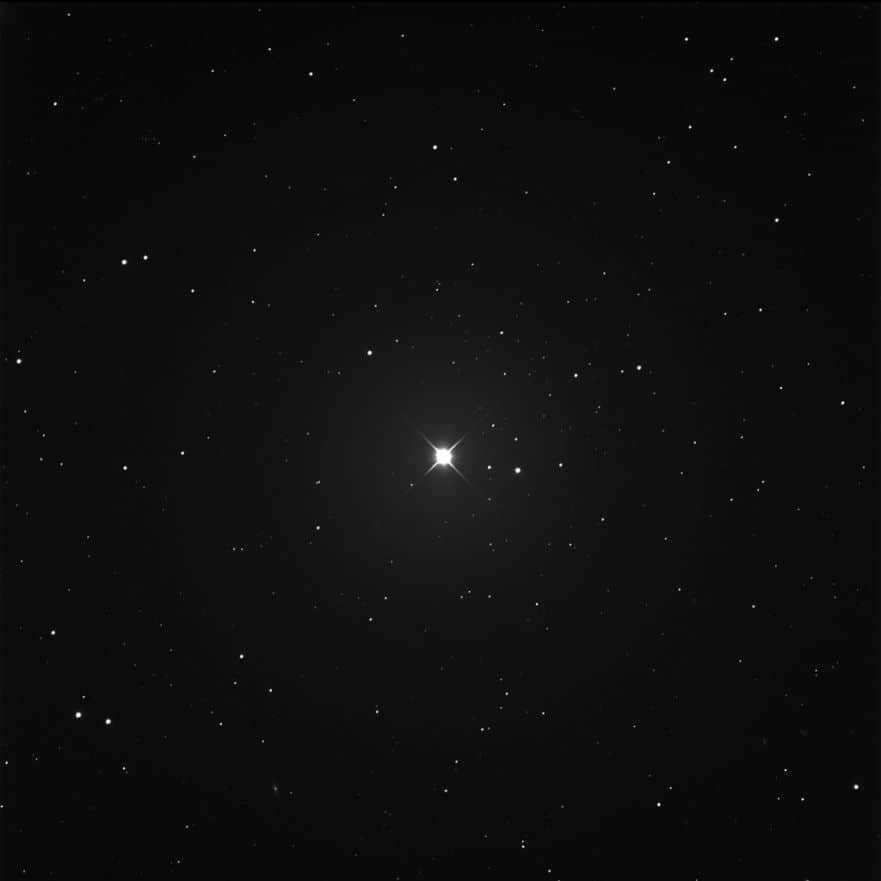

If the Sun were viewed from a distance of 30 light years, the 61 Virgo constellations would appear as they do in this 5-minute exposure.
109 Virgo is an A0V main-sequence white dwarf with a visual magnitude of 3.73, making it the 7th brightest star in the constellation. It is located 129 light years away and is 23 times brighter than the Sun.
Nu Virgo is an M1IIIab red giant with an apparent magnitude of 4.04. It is located 313 light years away and its brightness varies by 0.06 magnitudes.
The Virgo Cluster is a collection of galaxies located in the constellations Coma Berenices and Virgo. It is situated approximately 53.8 million light-years away from Earth.
This cluster is home to around 1300 galaxies, with some estimates suggesting there may be as many as 2000. The most notable galaxies within the Virgo Cluster were discovered during the late 18th and early 19th centuries and are documented in Messier’s catalog. In addition to the galaxies within the Virgo constellation, the cluster also contains galaxies from the neighboring Coma Berenices constellation, including M85, M88, M91, M98, M99, and M100.
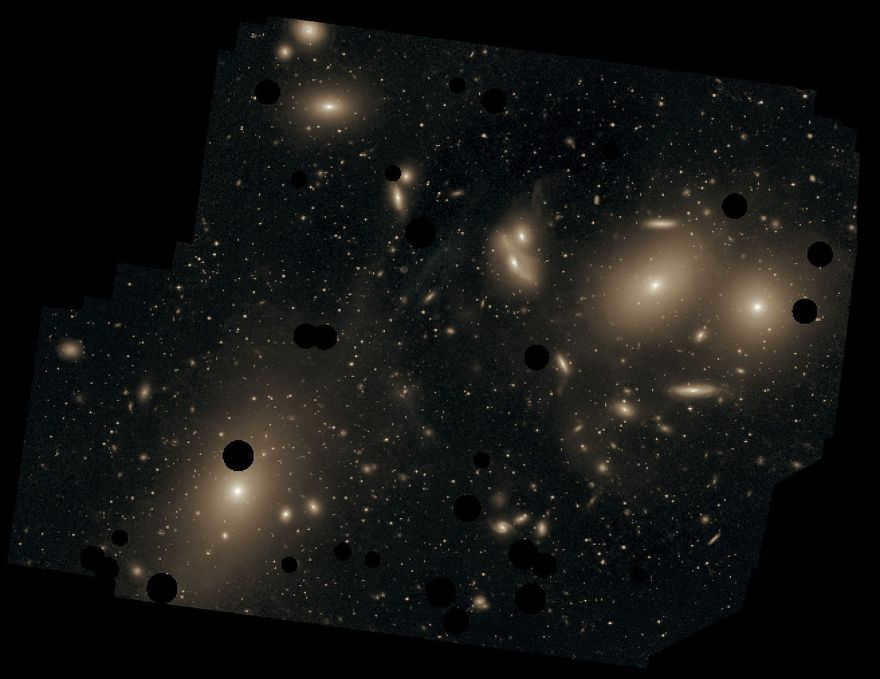

This profound image showcases the intergalactic light that permeates the cluster. The removal of prominent foreground stars is evident in the dark spots. At the bottom left, Messier 87 looms as the most massive galaxy captured in this picture.
Messier 49 (M49, NGC 4472) holds the distinction of being the brightest galaxy within the Virgo cluster and the first to be identified. Classified as an elliptical galaxy, it boasts a visual magnitude of 9.4 and is situated approximately 55.9 million light-years away.
There are 5900 globular clusters present in this galaxy, and it is estimated to be 10 billion years old. Over the past decade, scientists have identified two potential stellar-mass black holes that formed from the gravitational collapse of massive stars.
This galaxy is also believed to harbor a supermassive black hole at its core, which has a mass equivalent to 565 million suns. In June 1969, astronomers discovered a supernova known as SN 1969Q within this galaxy.
Charles Messier first discovered this galaxy in February 1771. It is located 4.1 degrees southwest of Epsilon Virgo. Currently, it is undergoing gravitational interactions with a small dwarf irregular galaxy called UGC 7636.
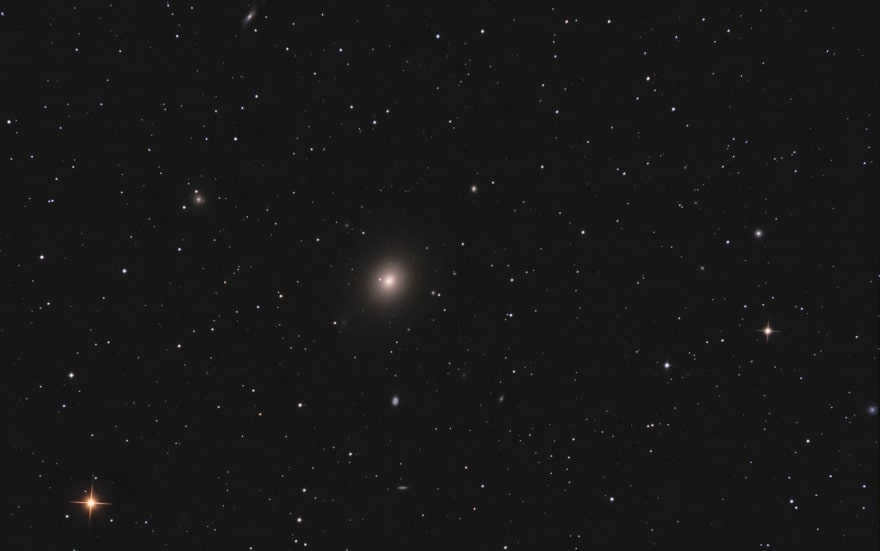
Messier 58 (M58, NGC 4579) is a spiral galaxy that has a visual brightness of 10.5 (making it one of the most luminous in the cluster) and is located approximately 62 million light-years away.
In April 1779, Charles Messier discovered Messier 58 along with the elliptical galaxies M59 and M60.
This galaxy has been the site of two supernova observations, namely SN 1988A in January 1988 and SN 1989M in June 1989.
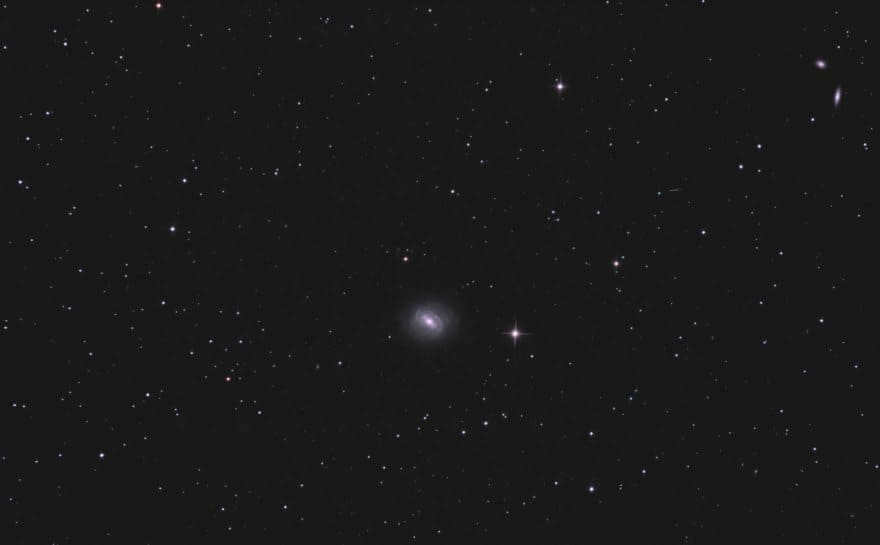
An infrared image showcasing Messier 58.
Messier 59 (M59, NGC 4621) stands as an elliptical galaxy boasting a visual magnitude of 10.6. This galaxy is positioned 60 million light-years away and can be found within the Virgo Cluster.
Messier 60 (M60, NGC 4649) is an elliptical galaxy with an apparent magnitude of 9.8. It resides 55 million light-years away and ranks as the third brightest member within the cluster. Notably, a supernova was discovered within this galaxy in the year 2004.
The optical disk of M60 overlaps with that of NGC 4647, which is positioned approximately 2.5′ away. However, despite this proximity, there is no evidence of gravitational interaction between the two galaxies. This suggests that they are located at different distances from our own system.
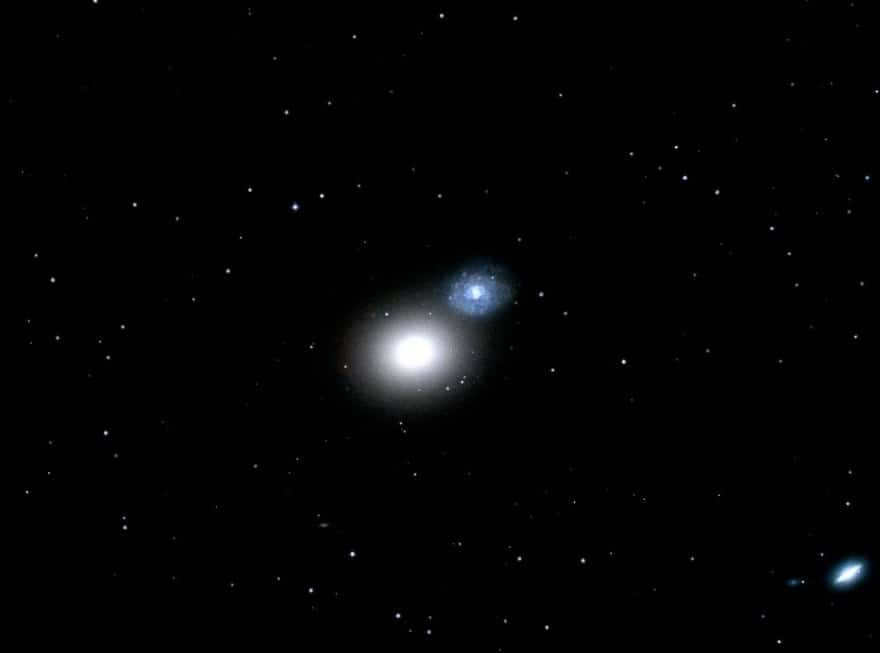
Messier 61 (M61, NGC 4303) is a spiral galaxy that has a visual magnitude of 10.18 and is located at a distance of 52.5 million light-years. It belongs to the Virgo Cluster.
Italian astronomer Barnaba Orini discovered Messier 61 in May 1779.
In the past century, scientists have recorded the presence of six supernovae in this galaxy: SN 1926A, SN 1961I, SN 1964F, SN 1999gn, SN 2006ov, and SN 2008in.
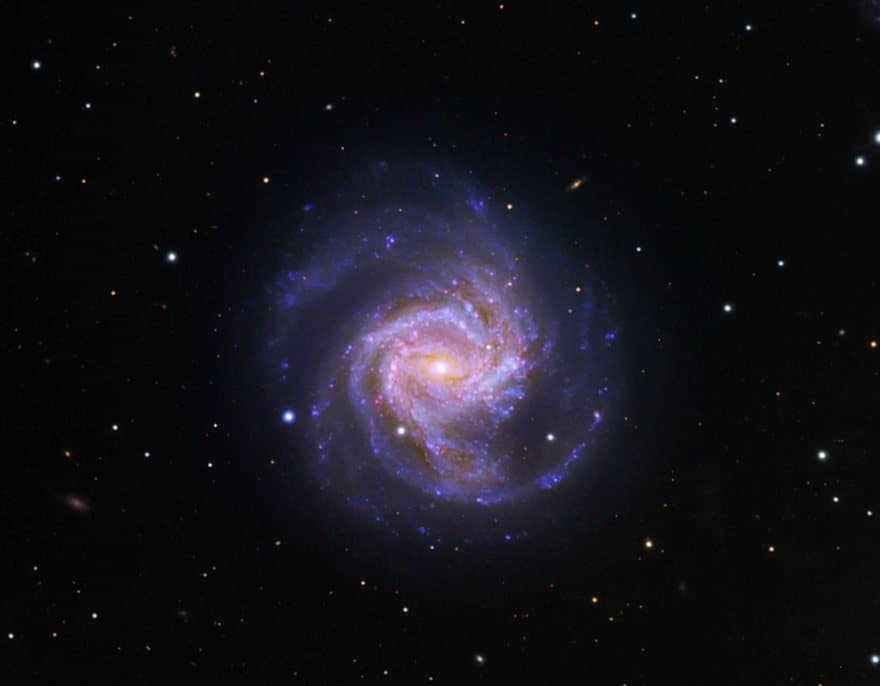
Infrared picture of the M61 galaxy.
Messier 84 (M84, NGC 4374) is a lenticular galaxy situated in the central region of the Virgo Cluster. It has an apparent magnitude of 10.1 and is located 60 million light-years away. It contains a rotating disk of gas and stars that rotate at high velocities, suggesting the possible presence of a supermassive black hole.
This galaxy was first identified by Charles Messier in March 1781. Two supernovae events, SN 1957 and SN 1991bg, have been observed in this galaxy.
Messier 86 (M86, NGC 4406) is another lenticular galaxy positioned near the core of the Virgo Cluster. It is located 52 million light-years away and has an apparent magnitude of 9.8. Charles Messier discovered it in 1781.
M86 is currently moving towards our galaxy at a speed of 244 kilometers per second.
With a visual magnitude of 9.59, it holds the position of the second most luminous galaxy within the cluster. Furthermore, it stands out as one of the most substantial entities within the local universe. The year of its discovery dates back to 1781, and it was Charles Messier who first observed it. Its location is found at a staggering distance of 53.5 million light years away.
Messier 87 and Messier 86 are currently in motion towards each other. Within the former, a supermassive black hole has been documented at its core. This particular galaxy can be classified as a C-type or supergiant D-class galaxy, boasting a vast halo of stars, an elliptical nucleus, and an expansive diffuse shell devoid of any dust particles.
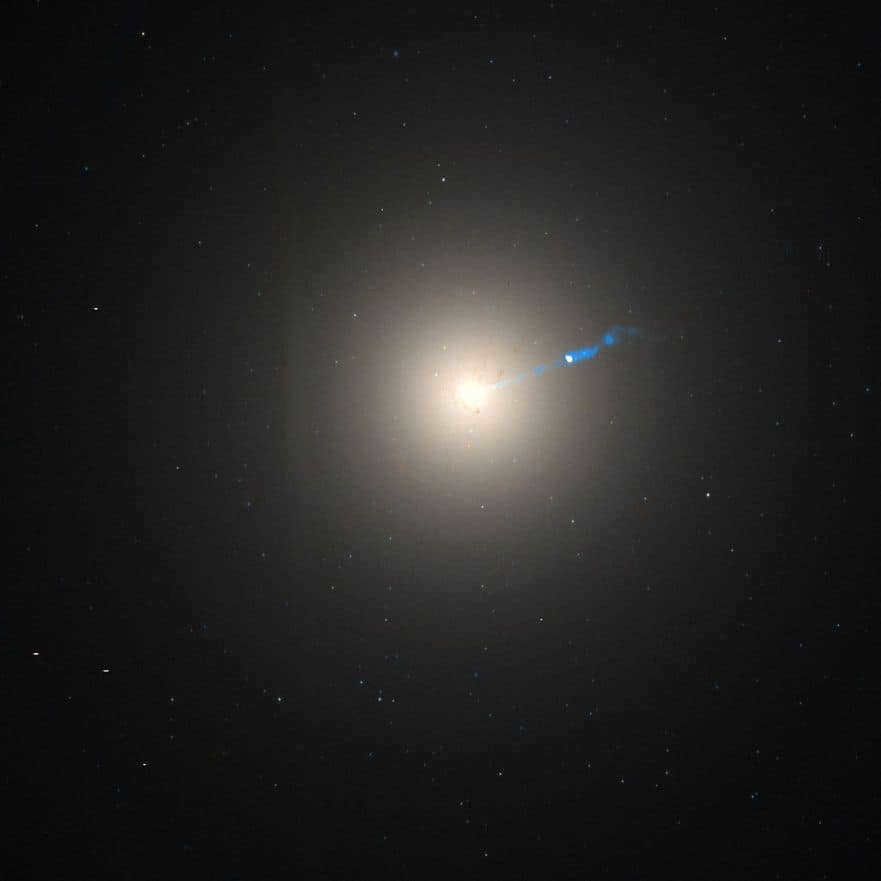
Messier 89 (M89, NGC 4552) is an elliptical galaxy that has a visual magnitude of 10.73 and is located approximately 50 million light-years away. It is part of the Virgo Cluster. Charles Messier discovered this galaxy in March 1781. Within a range of 25 degrees, there are around 2000 globular clusters (150-200 in the Milky Way).
Scientists believe that M89 was previously a radio galaxy or an active quasar. It has a disk made up of gas and dust that extends to 150,000 light-years, and there are also visible jets of hot particles that stretch 100,000 light-years outward.
Messier 90 (M90, NGC 4569) is a spiral galaxy that has a visual magnitude of 10.26 and is situated approximately 58.7 million light-years away. Its discovery is credited to Charles Messier in the year 1781. This galaxy is a constituent of the Virgo Cluster and is positioned 1.5 degrees away from the M87 subgroup.
The spiral arms of M90 lack distinctive features, and the regions where stars are formed appear to be shortened due to interaction with the surrounding environment within the Virgo Cluster. As a result, M90 is classified as an anemic spiral galaxy, characterized by a low contrast between its disk and spiral arms.
The Sombrero Galaxy (M104, NGC 4594) is a spiral galaxy without a discernible junction. It has a visual magnitude of 8.98 and is located approximately 29.3 million light-years away. Amateur astronomers can observe it using a telescope. It can be found in the southern region of the Virgo Cluster, positioned 11.5 degrees west of Spica.
The sombrero galaxy, also known as Messier 104, is thought to be a massive elliptical galaxy housing a supermassive black hole at its core. Discovered by Pierre Mechene in March 1767, this remarkable galaxy is characterized by an extraordinary central bulge and a dusty band in its disk, resembling the shape of a sombrero hat. It is estimated to contain between 1200 and 2000 globular clusters, adding to its unique and captivating nature.
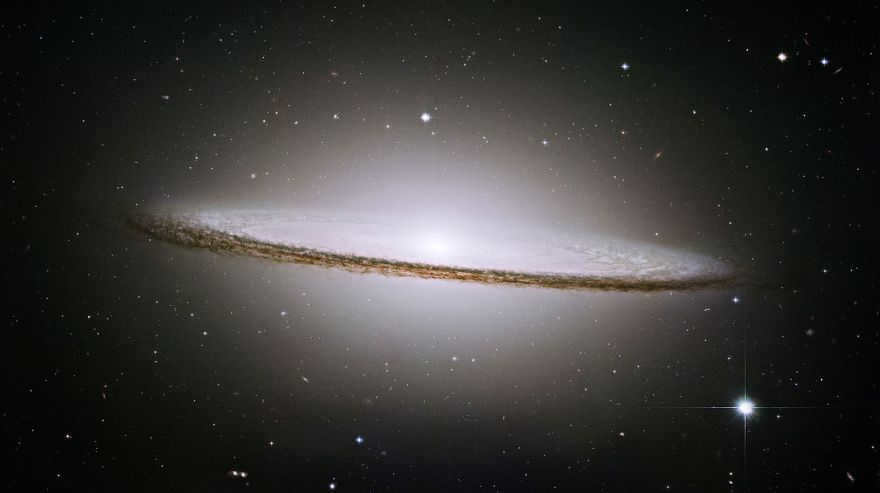
 The renowned Sombrero Galaxy (M104) is an illuminated spiral galaxy in close proximity. Its remarkable dust lane and the presence of a halo of stars and globular clusters give it an extraordinary appearance. The central region of the galaxy displays noticeable X-ray activity, which has led numerous scientists to believe that a black hole, weighing a billion times more than our sun, is concealed inside.
The renowned Sombrero Galaxy (M104) is an illuminated spiral galaxy in close proximity. Its remarkable dust lane and the presence of a halo of stars and globular clusters give it an extraordinary appearance. The central region of the galaxy displays noticeable X-ray activity, which has led numerous scientists to believe that a black hole, weighing a billion times more than our sun, is concealed inside.
The Virgo Cluster houses a fascinating cosmic duo known as the Eyes of Virgo (NGC 4435 – NGC 4438, Arp 120). These two galaxies are currently engaged in a mesmerizing interaction.
NGC 4435, a lenticular galaxy, showcases a vibrant population of youthful stars concentrated in its core. This burst of stellar activity is believed to have been triggered by its close encounter with NGC 4438.
On the other hand, NGC 4438 presents a more complex structure, featuring a prominent disk and elongated tidal tails resulting from its interactions with neighboring galaxies. This intricate appearance makes it challenging to classify as either a spiral or lenticular galaxy.
Separated by a staggering distance of 52 million light years, these celestial marvels continue to captivate astronomers and enthusiasts alike.
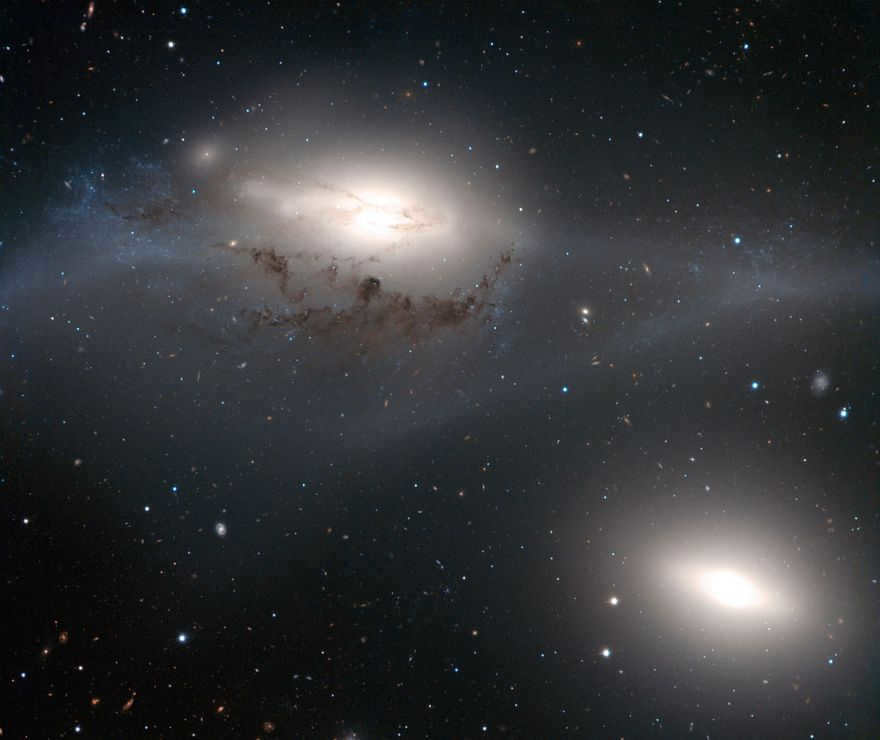

You are witnessing a beautiful and unique pair of galaxies – NGC 4438 and NGC 4435, which have earned the nickname the Eyes. NGC 4438 (top) used to be a spiral galaxy until it was altered due to collisions with other galaxies.
NGC 4216 is an intermediate spiral galaxy with a visual magnitude of 11 and located 40 million light-years away.
With an absolute magnitude of -22, it is one of the largest and brightest galaxies in the cluster.
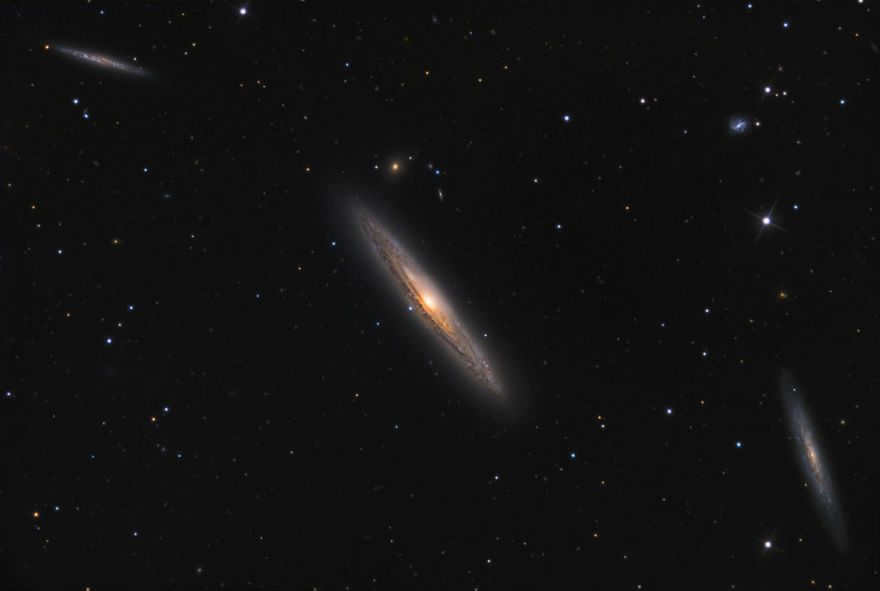
The Siamese Twins (NGC 4567 and NGC 4568) are two spiral galaxies that have a combined visual brightness of 10.9 and are located about 59.4 million light-years away from us. These galaxies are currently in the midst of a collision, where they are merging with one another. It was William Herschel who first discovered these galaxies back in 1784.
Back in 2004, there was an observation of a supernova event within this system.
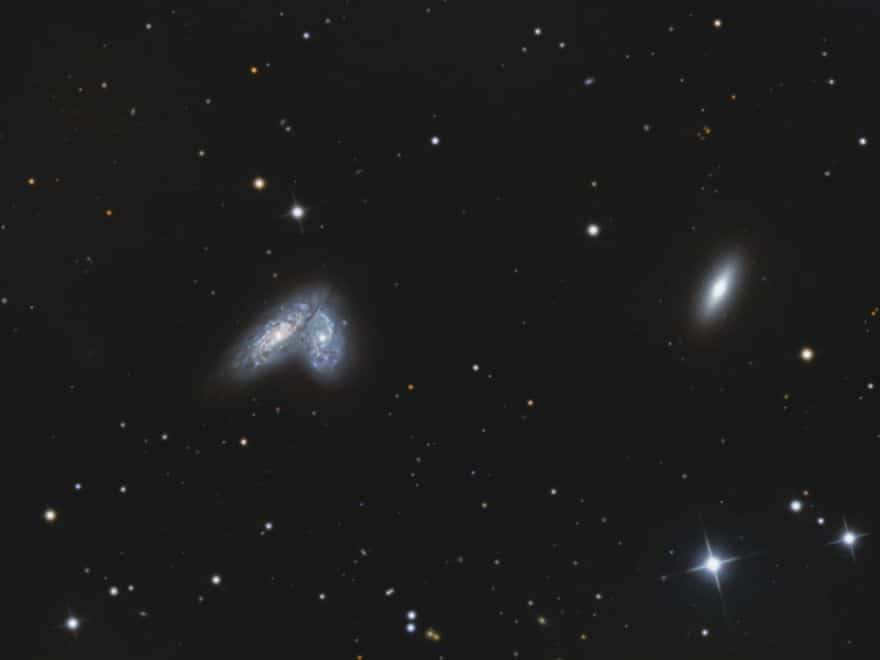
The Virgo Cluster contains NGC 4526, a lenticular galaxy that can be observed with a visual magnitude of 10.7 and is located 55 million light years away.
Within this galaxy, astronomers have identified two supernovae: SN 1969E and SN 1994D.
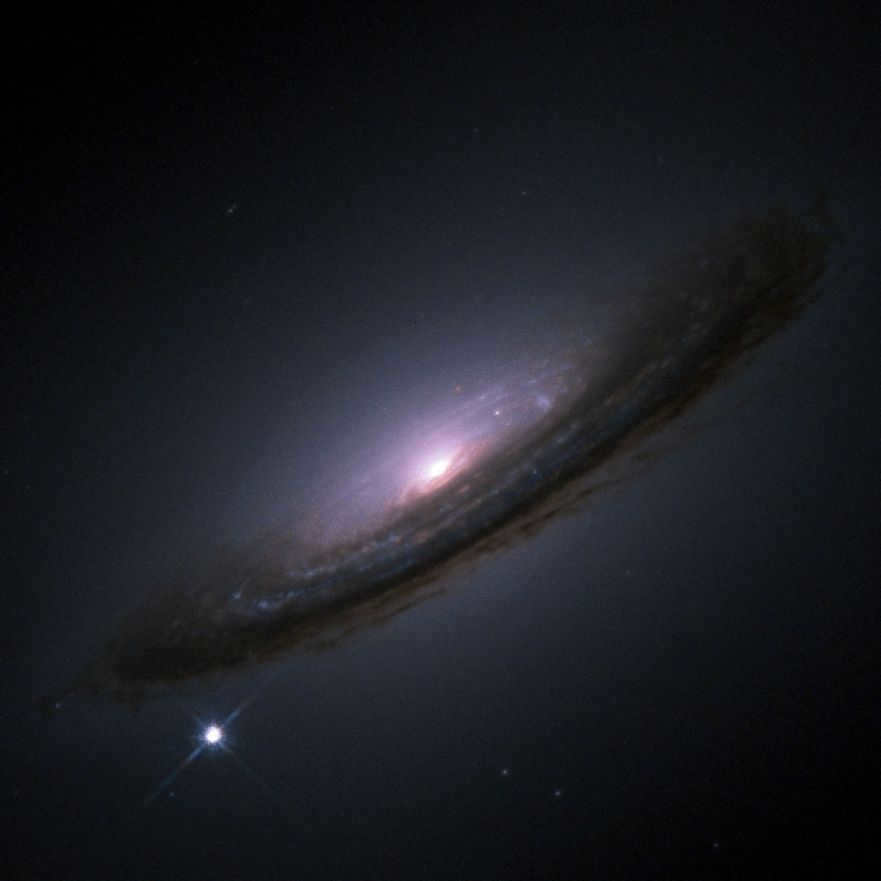
There is a picture of a supernova called SN1994D in the NGC 4526 galaxy.
NGC 4261 is an elliptical galaxy with a visual magnitude of 11.4. It can be found 96 million light-years away in the Virgo Cluster.
This galaxy stretches out to 60000 light-years in width and contains a supermassive black hole at its center, which has a mass equivalent to 400 solar masses.
3C 273 is a quasar, which is an energetic and distant active galactic nucleus or quasi-stellar radio source. It was the first of its kind to be identified and is also the brightest one in the sky.
It is located at a distance of 2.443 gigas light years and was one of the initial extragalactic X-ray sources discovered in 1970. It is situated at the base of a large elliptical galaxy.
This object is known as a blazar, a remarkably compact quasar linked to a hypothetical supermassive black hole located at the core of an active gigantic elliptical galaxy.
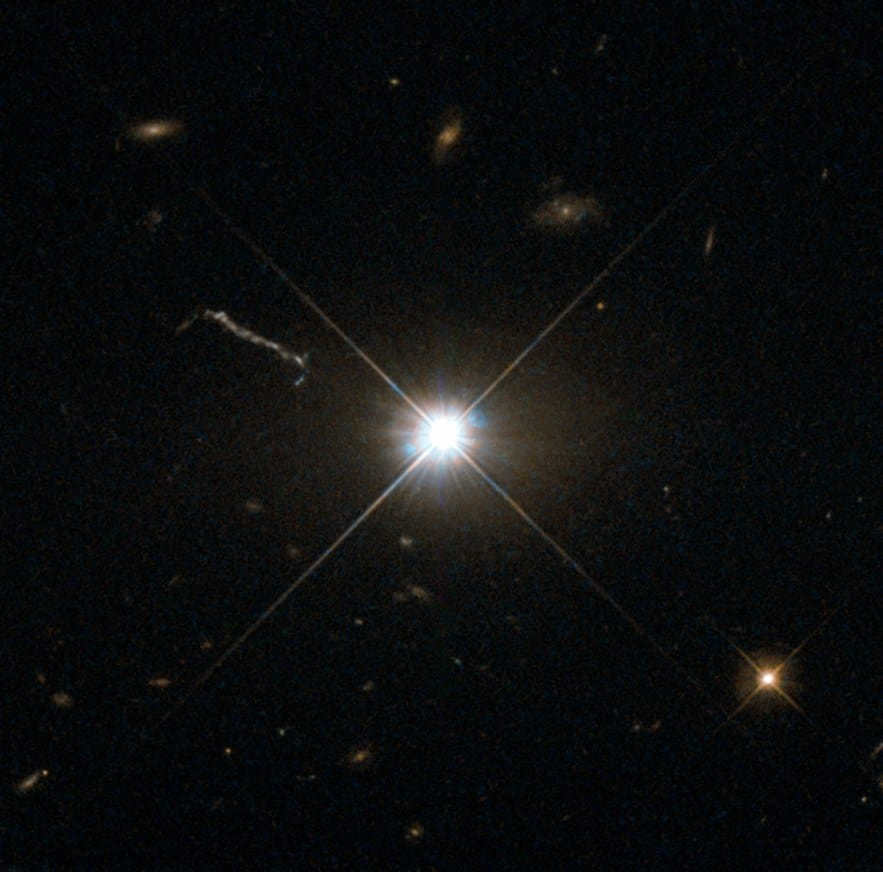
If you want a more in-depth exploration of the Virgo constellation, you can utilize not only our collection of images but also access 3D models and online telescopes. To aid in your personal search, a static or movable star map would be appropriate.
- Television ProgramConvenient TV program for the week, provided by Akado TV guide.
- Photography EnthusiastA plugin for publishing photos in a user’s diary. Minimum system requirements: Internet Explorer 6, Fire Fox 1.5, Opera 9.5, Safari 3.1.1 with JavaScript enabled. It may work.
- PostcardsA revamped catalog of postcards for all occasions.
- Affordable flight ticketsGreat deals, convenient search, no hidden fees, available 24/7. Reserve now and pay later!
–Music
–Photo gallery
–Online multiplayer board games
–Video URL converter
–Search for a Diary
–Subscribe via Email
Starting from August 23rd, the Virgo constellation fills the zodiacal sky. It’s time to acquaint ourselves with this constellation and its earthly representatives.
Within the dark expanse
Of the southern sky’s edge
Shines the eagle Altair
And the Southern Cross glows.
In the far reaches of the universe’s northern edge
The lyre beckons,
The back of the Maiden glimmers,
The swan Deneb is ablaze.
The heavens are alluring
In the enigma of the silent night.
With a distant radiance
The stars burn overhead.
Step out of your dwelling one day
Onto the Milky Way
Follow the stars’ dream,
But never forget the Earth.
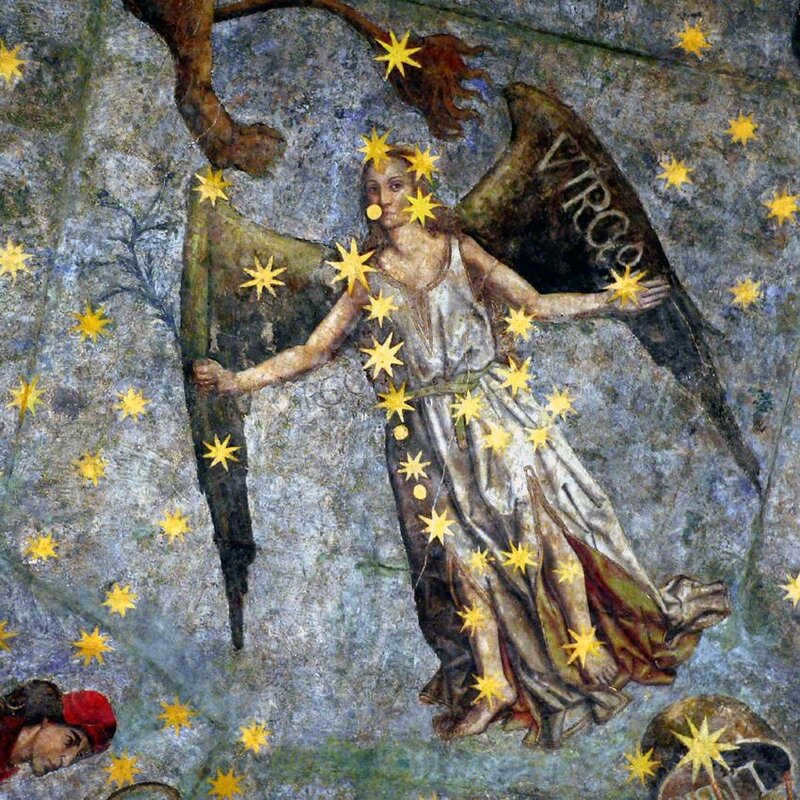
Virgo, the zodiacal constellation. It is one of the largest constellations in the night sky, not only among its zodiacal counterparts but also the second largest (after Hydra) in the entire sky.
Territorially, Virgo is located on the celestial equator, between the constellations of Leo and Libra. Due to the precession of the Earth’s axis, it is currently in this constellation that the autumnal equinox occurs.
Because of its considerable size, the constellation houses the Sun for a period of over a month, specifically from September 16 to October 30.
In regions with moderate latitudes, the constellation can be seen in the morning sky from November to February, while in the spring it can be observed throughout the night. In the months of June and July, it becomes visible during the evening hours.
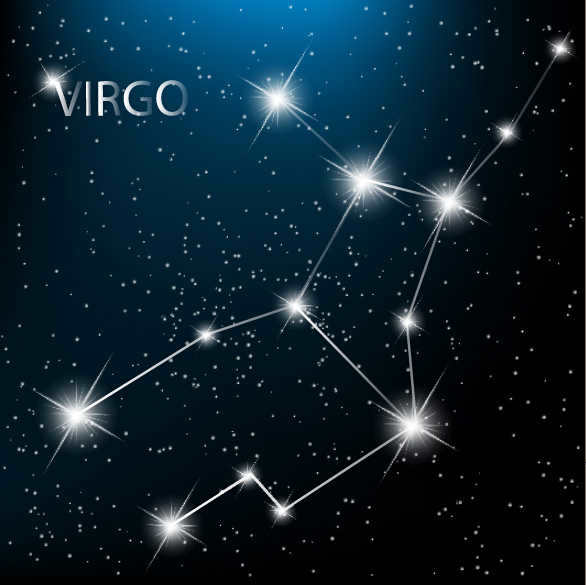
Virgo, in Latin, means “maiden/virgin”.
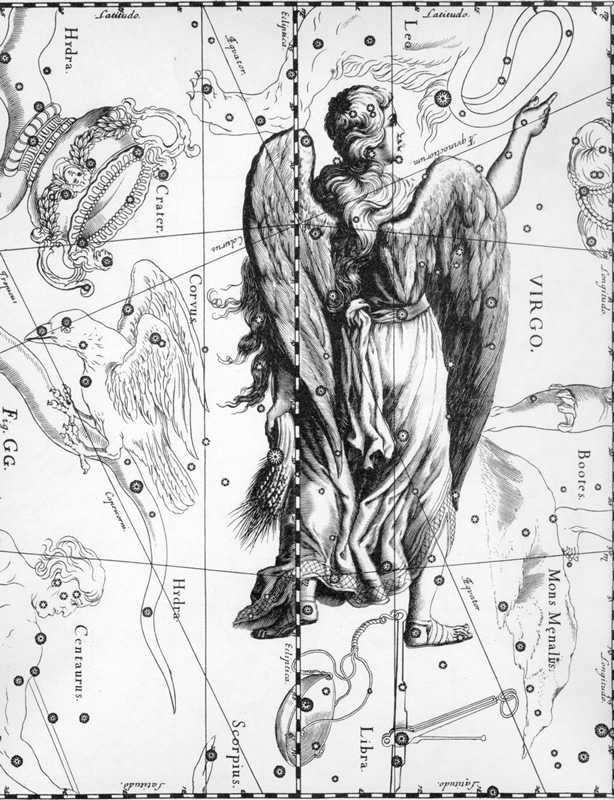
The ancient constellation is part of the star catalog known as Almagest by Claudius Ptolemy.
Virgo constellation contains a total of 194 stars, with the brightest one being Spica (ranked 16th in terms of brightness).
Spica (α Virgo), which translates to “spike” in Latin, is a massive double star with a stellar magnitude of 0.98. Porrima (γ Virgo), meaning “goddess of prophecies,” is one of the closest double stars to us, located at a distance of 32 light-years.
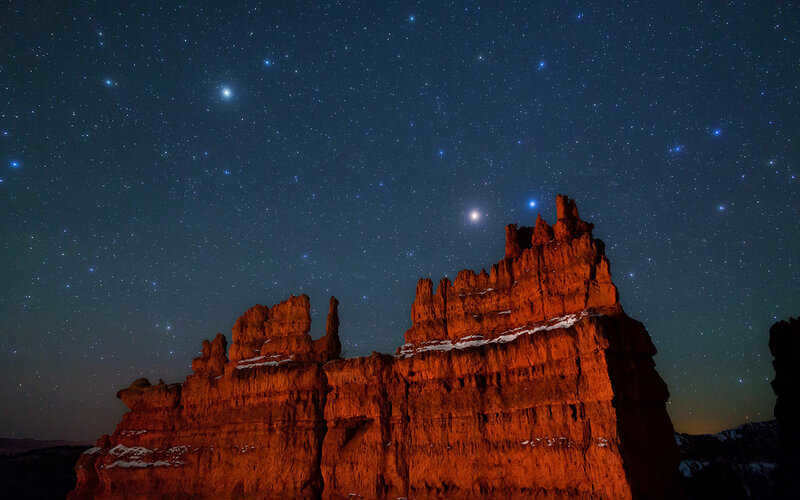
Over a rock in Bryce Canyon National Park, USA, you can see the beautiful alignment of Arcturus, Mars, and Spica in the night sky.

Did you know that Spica is not only visible in the sky, but also on the national flag of Brazil?
Here’s another interesting fact about this celestial object: the discovery of the phenomenon of precession was made possible thanks to Spica. This star is located near the ecliptic, which means that it can sometimes be obscured by the Moon. It is even rarer to see Spica covered by planets in our solar system. The last time this occurred was in 1783, when Venus “eclipsed” this star. The next planetary eclipse of Spica is expected to occur in September 2197. It’s not too long to wait!
Virgo was often represented on ancient star maps holding a bundle of wheat in place of the star Spica, which means “spike” and symbolizes a bountiful harvest and fertility. Additionally, the ancient Egyptians believed that the stars in the Milky Way were actually grains of wheat scattered across the sky.
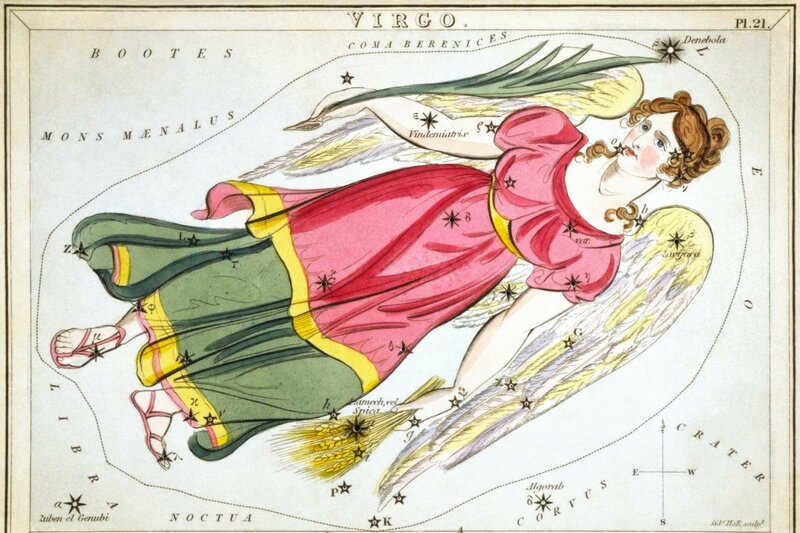
The constellation Virgo is well-known for its enormous collection of galaxies situated in the northern region of Virgo and the southern region of Veronica’s Hair. This nearest super cluster of galaxies is located 50 million light years away from our planet and consists of approximately two thousand celestial objects.
Now, let us examine a few of these fascinating entities:
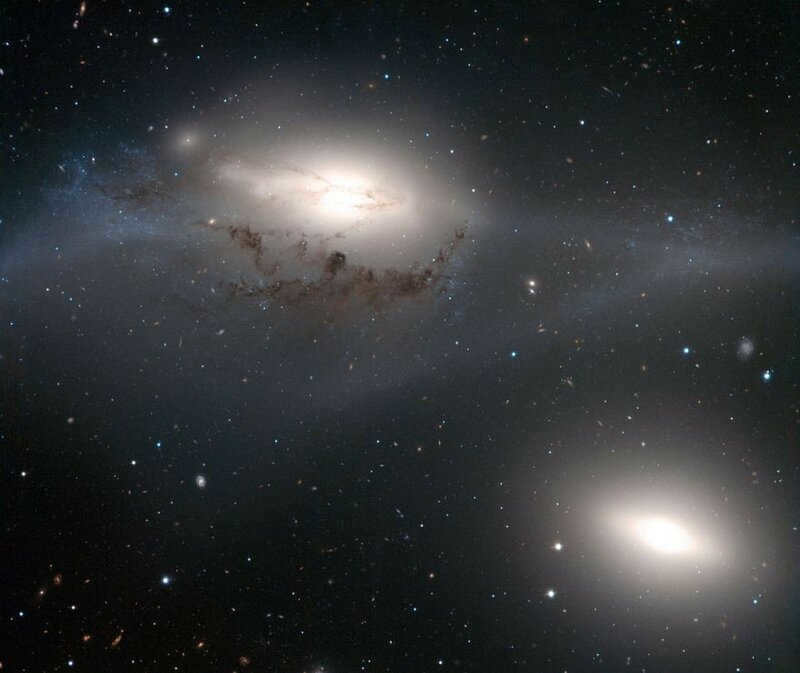
Presented here is a remarkable celestial duo known as NGC 4438 and NGC 4435, affectionately referred to as the Eyes. These fascinating galaxies, also known as the Eyes of Virgo, are separated by a staggering distance of 52 million light years.
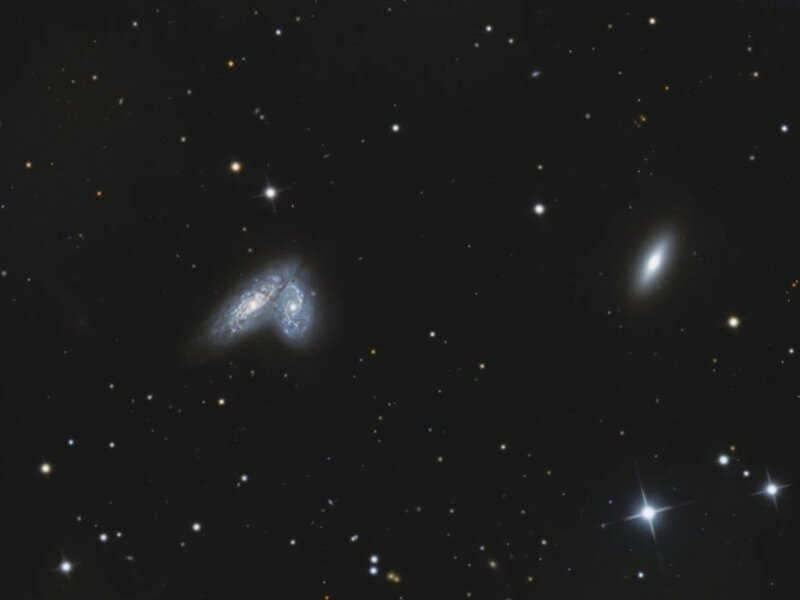
The Twin Siamese (NGC 4567 and NGC 4568) are a duo of spiral galaxies
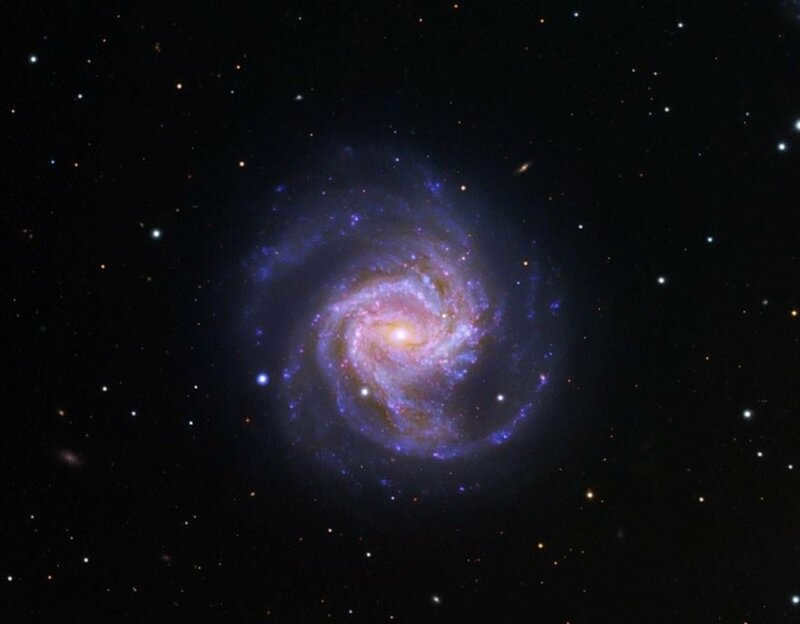
A picture of the spiral galaxy M61 in the infrared spectrum.
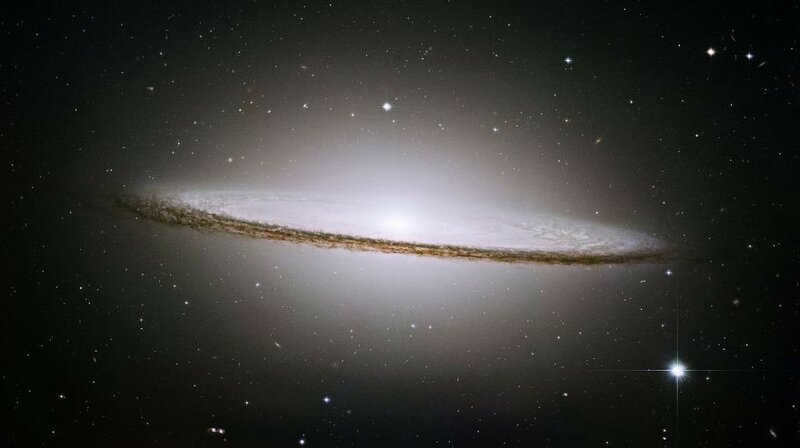
The well-known M104 galaxy, also known as the Sombrero galaxy, is a spiral galaxy located nearby. It has a distinctive shape due to the presence of a prominent dust lane and a halo consisting of stars and globular clusters.
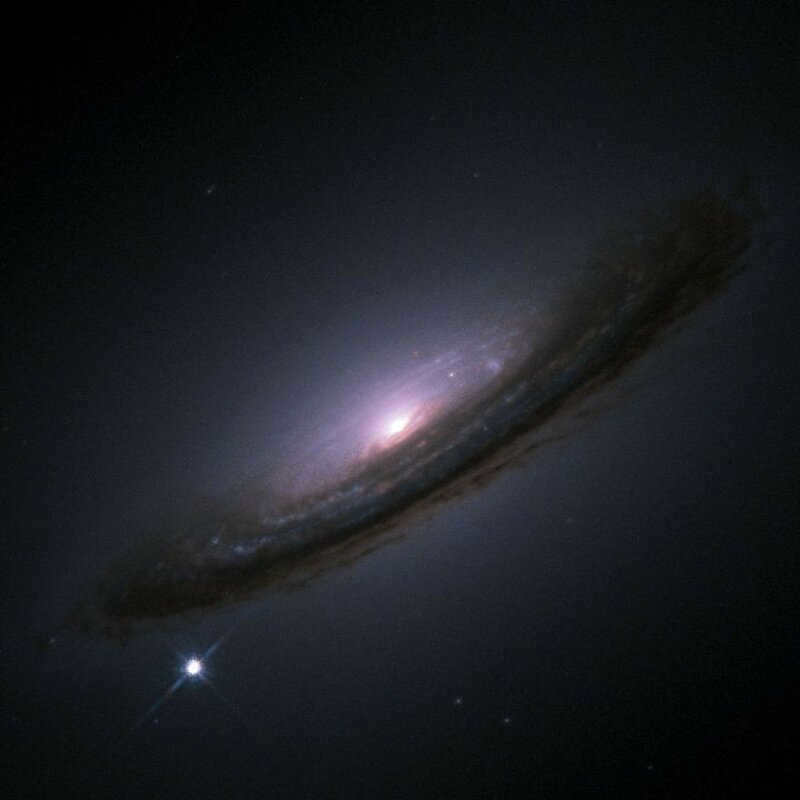
An illustration of the supernova star 1994D (SN1994D) located in the NGC 4526 galaxy.
Running through the center of the Virgo cluster of galaxies is an extraordinary series of galaxies called the Markarian chain.
This constellation is the home of Virgo-A, one of the most powerful radio sources, and the first quasar discovered by humans.
The mythological story behind the Virgo constellation.
The most common representation of this constellation is the Greek goddess of justice, Dike. She is known as the daughter of Zeus and Themis.

According to ancient Greek mythology, Dike was present during the Golden Age of humanity. She was originally mortal and resided on Earth to establish justice. During this period, there was peace and serenity, and people did not experience old age. However, when Zeus defeated Cronus, the Silver Age commenced, and things took a turn for the worse. Zeus introduced the four seasons and people ceased to worship the gods.
Dike opposed these changes and warned of impending doom. She retreated to the mountains and turned her back on humanity. As the Bronze and Iron Ages arrived, and wars erupted, Dike grew disheartened and abandoned Earth, finding solace near the constellation Libra. As we know, Libra is now associated with justice.
The constellation Virgo is also connected to the goddess Demeter, known for her association with fertility. She is believed to have imparted knowledge to humans about farming, cultivating fields, and promoting honorable unions. The tale of Demeter embodies the eternal battle between existence and mortality.
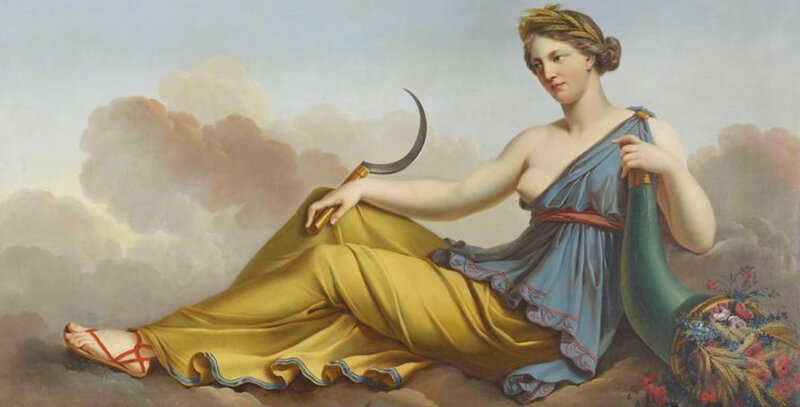
Pluto abducted Persephone, daughter of Demeter, and took her to his realm, where he made her his spouse. Demeter informed Jupiter that she would neglect the earth until her daughter was restored to her. Consequently, a chilling spell descended upon the land, endangering the fate of humanity.
Jupiter has agreed to return Persephone to her mother, but Pluto is cunning. He managed to convince the unsuspecting Persephone to consume a few pomegranate seeds, which were symbolically associated with marriage, thus causing Persephone to forfeit her right to leave Pluto’s side.
In order to resolve this predicament, the gods convened and decided that Persephone would spend two-thirds of the year on the surface with her mother, while the remaining one-third would be spent underground in Pluto’s realm beneath the earth.
Thus, for two-thirds of the year, the earth blossoms and flourishes, but when winter arrives, nature retreats into hibernation: the grief-stricken Demeter dons mourning attire and becomes melancholic.
At times, Virgo is associated with the Syrian goddess of fertility, Erigon (who was the daughter of Icarius). The young girl tragically took her own life following her father’s death, and she is often linked to the Magus.
![20051225-151425_Jordan_Archeological_Museum_Amman_Atargatas_[Atargatis].med.jpg](/wp-content/uploads/images/kak-davno-izvestno-sozvezdie-devy_48.jpg)
The constellation of Virgo has long been associated with the Syrian goddess of fertility, Erigon.
According to Erastothenes and Hyginus, the constellation is also linked to the goddess of prosperity, Tuhe, who is often depicted carrying a cornucopia.
Another prominent star in the constellation is known as Vindemiatrix. This star was believed to represent Ampel, a young man who was transformed into a star. Ampel was the lover of Dionysus, the god associated with the bountiful harvest and winemaking.
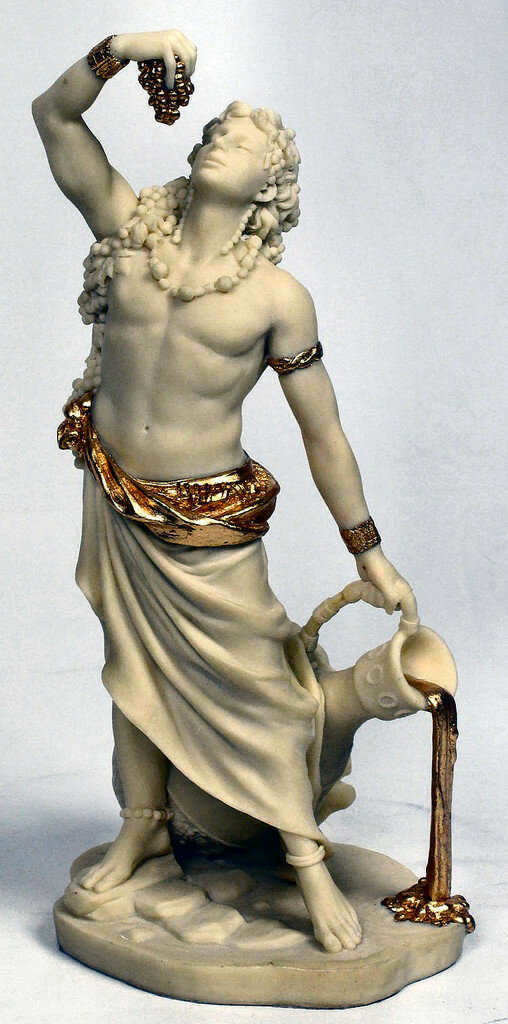
Ampelus, the admirer of Dionysus
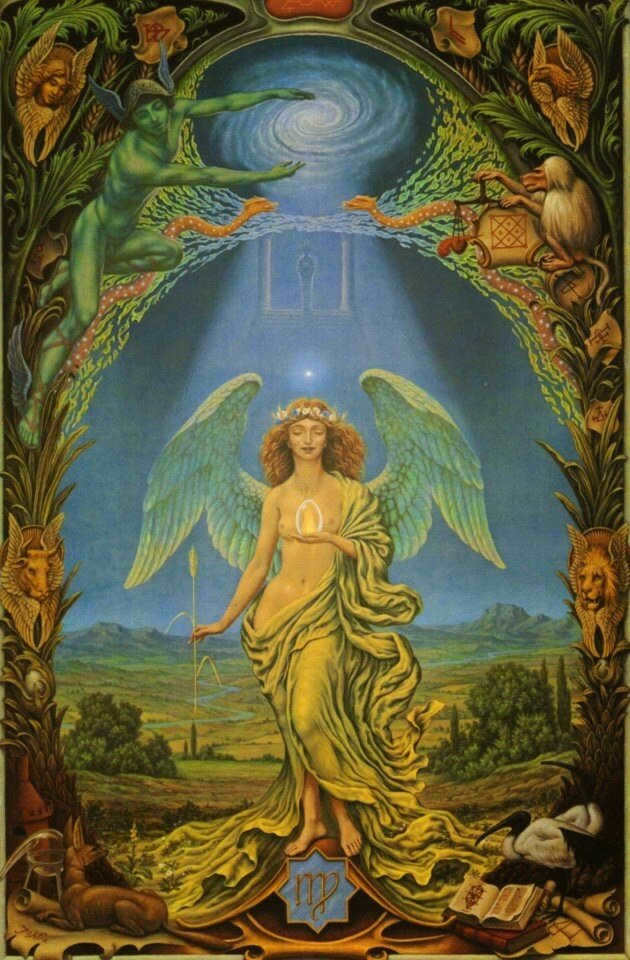
Virgo, which is one of the 12 constellations in the zodiac, was documented by Ptolemy in the second century
It is the sixth constellation in the Zodiacal Circle
Its astrological dates are from August 23 to September 23
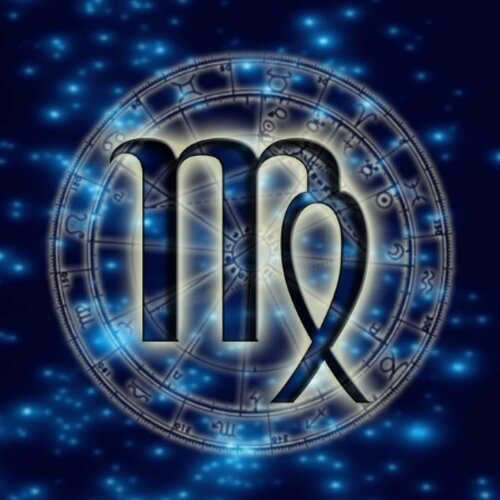
Polarity – yin/feminine sign, negative sign.
Colors – brown, gray.
Metal – tin.
Stones – jasper, cat’s eye, agate, carnelian.
Plants – asters, poppies, pansies, daisies, mother and stepmother, mint, all medicinal herbs and grains.
Animals – dogs and all pets.
Virgos born in different decades have unique characteristics.
1. Virgo, born in the first decade – from August 24 to September 2 – is influenced by the Sun. They possess a calm demeanor, intelligence, resilience, stability, and a strong sense of duty.
2. Virgo, born in the second decade – from September 3 to September 11 – is influenced by Venus. They tend to be secretive, shy, indecisive, and pedantic.
3. Virgo, born in the third decade – between September 12 and 22 – is under the influence of Mercury. They possess resourcefulness, cunningness, pragmatism, laziness, and tend to be late in starting a family.

Astrologically speaking, the constellation of Virgo represents purity, justice, chastity, and virtue. This may explain why individuals born under this zodiac sign have exceptionally high standards when it comes to their romantic partners. It is challenging for an ordinary person to meet their lofty ideals.
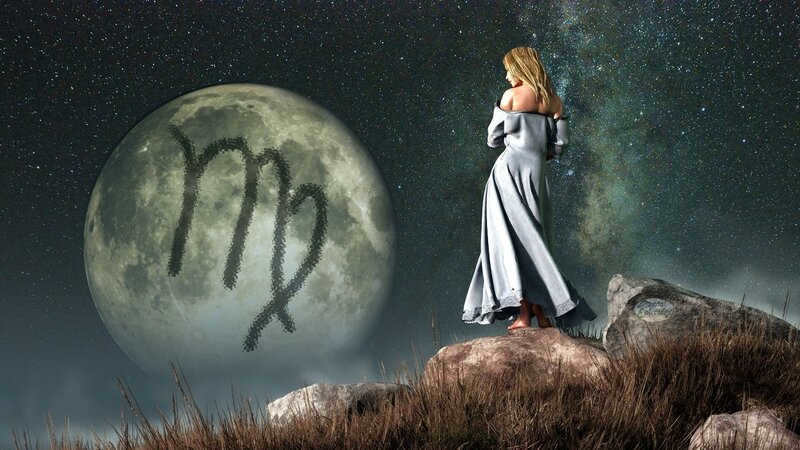
Typically, individuals born under the sign of Virgo are known for their meticulous attention to detail and their ability to organize things effectively, although they may sometimes overlook the bigger picture.
Most Virgos tend to be hoarders and enjoy saving for the future. They accumulate material possessions as a way to feel more secure and ensure a comfortable retirement. Efficiency and economy are words that resonate with them. Virgos also make excellent hosts and are known for their ability to create a sense of order in their living spaces.
The mission of a Virgo is to combat chaos and bring order to the universe.
 Flight to Mercury, a gift from God, DIDYULYA 20.08.2014 –> Viewed: 13 (1)
Flight to Mercury, a gift from God, DIDYULYA 20.08.2014 –> Viewed: 13 (1)  DIDYULYA 25.07.2014 –> Viewed: 49 (1)
DIDYULYA 25.07.2014 –> Viewed: 49 (1)
–Search through journal entries
–Receive updates via email
–Connections
–Loyal followers
–Communities of interest
–Data and analytics
The Virgo constellation in the fields of astronomy, astrology, and mythology
From August 23rd onwards, the constellation Virgo dominates the zodiac sky. It is an opportune time to familiarize ourselves with this constellation and its earthly representatives.
Amidst the velvety darkness
On the southern horizon
Shines the majestic Altair
And the Southern Cross illuminates
On the northern reaches of the cosmos
The lyre beckons
The Maiden’s silhouette twinkles
The swan Deneb burns brightly
All the skies are stunning
During the enigma of the silent night.
With an ethereal glow
The celestial bodies shine high in the sky.
Step outside of your dwelling one day
To traverse the Milky Way
Pursue your celestial aspirations,
Yet always remember the planet we call home.

Virgo is a zodiacal constellation and is known to be one of the largest constellations in the night sky. It holds the distinction of being not only the largest zodiacal constellation, but also the second largest constellation overall (with Hydra being the largest).
The constellation Virgo is located on the celestial equator, between the constellations Leo and Libra. Due to the Earth’s axial precession, it is currently the location of the autumnal equinox in our era.
Because of its considerable size, the constellation hosts the Sun for over a month – from September 16 to October 30.
In the mid latitudes, the constellation is visible in the morning from November to February, and in spring it can be observed throughout the night. In June and July, it can be seen in the evening hours.

Virgo is derived from the Latin word “virgo” which means “maiden” or “virgin”.

The ancient constellation known as Virgo is listed in Claudius Ptolemy’s Almagest star catalog.
Virgo consists of 194 stars, with the brightest being Spica, which is ranked 16th in terms of stellar brightness.
Spica (α Virgo), which translates to “spike” in Latin, is a massive double star with a stellar magnitude of 0.98. The star Porrima (γ Virgo), also known as the “goddess of prophecies”, is one of the closest double stars to Earth, with a distance of 32 light years.

The constellation of Virgo, along with the planets Arcturus, Mars, and Spica, can be seen above a large rock formation in Bryce Canyon National Park in the United States.

Did you know? Spica is not only visible in the sky, but it is also featured on the national flag of Brazil.
Here’s another fascinating fact about this celestial object: it was actually Spica that led to the discovery of the phenomenon known as precession. This star is situated in close proximity to the ecliptic, which means that it can occasionally be eclipsed by the Moon. It is rarer to see Spica being covered by planets from our solar system. The last time this occurred was in 1783 when Venus eclipsed this star. The next planetary eclipse of Spica is anticipated to take place in September 2197. It’s not a “long” wait, right?

The constellation Virgo is renowned for the enormous collection of galaxies that can be found in the northern region of Virgo and the southern portion of Veronica’s Hair. This nearby supergroup of galaxies is located 50 million light years away from our planet and consists of approximately two thousand celestial objects.
Now, let us examine a few of these fascinating entities:

A unique and fascinating sight awaits you in the form of a galaxy duo known as NGC 4438 and NGC 4435, affectionately referred to as the Eyes. These celestial wonders, also known as the Eyes of Virgo, are situated approximately 52 million light years away from each other.

The Siamese Twins (NGC 4567 and NGC 4568) consist of two spiral galaxies that are closely connected.

This is an infrared picture showcasing the beautiful spiral galaxy known as M61.

The well-known Sombrero galaxy (M104) is a luminous spiral galaxy in close proximity. It possesses a distinctive form, characterized by a prominent dust lane and an encompassing halo of stars and globular clusters.

An image depicting the occurrence of the supernova star 1994D (SN1994D) in the galaxy NGC 4526.
Within the Virgo cluster of galaxies, there exists a fascinating alignment of galaxies referred to as the Markarian chain.
Located within this constellation is the source of one of the most potent radio emissions, Virgo-A, and the first quasar ever discovered by humans.
The mythological significance of the Virgo constellation
The constellation is often associated with the Greek goddess of justice, Dike. She is recognized as the daughter of Zeus and Themis.

During the Golden Age of mankind, as per the ancient Greek myths, Dike, a mortal being, resided on Earth with the purpose of ensuring justice. This era was characterized by peace and serenity, and the concept of old age was unknown to people. However, the arrival of the Silver Age, following the demise of Cronus at the hands of Zeus, brought about challenges. Zeus introduced four seasons and people ceased to honor the gods. Dike opposed these changes and warned of impending doom. Consequently, she retreated to the mountains, turning her back on humanity. When the Bronze and Iron Ages arrived, marked by wars and conflicts, Dike abandoned Earth, finding solace near the constellation Libra. It is worth noting that justice is closely associated with Libra in modern times.
The constellation Virgo is also connected with the goddess of fertility, Demeter. The legend of Demeter symbolizes the eternal battle between life and death. The legend of Demeter symbolizes the eternal battle between life and death.

Pluto abducted Persephone, the daughter of Demeter, and took her to his realm where he made her his spouse. Demeter informed Jupiter that she would neglect the land until her daughter was brought back to her. Consequently, a chilling winter descended upon the earth, posing a peril to humanity.
Jupiter has agreed to send Persephone back to her mother, but Pluto has played a trick. He managed to deceive Persephone and convinced her to eat a few pomegranate seeds, which were considered a symbol of marriage. By doing so, Persephone lost her right to leave Pluto’s realm.
To resolve this predicament, the gods held a council and decided that Persephone would spend two-thirds of the year on the surface with her mother and one-third of the year underground, in Pluto’s kingdom beneath the earth.
During the two-thirds of the year when Persephone is with her mother, everything on earth blossoms and turns green. But when winter arrives, nature goes into hibernation: Demeter, who feels abandoned, mourns and wears sorrowful attire.
At times, Virgo is associated with the Syrian goddess of fertility, Erigon, who was the daughter of Icarius. Erigon tragically took her own life after her father’s death, and she is also linked to the Magus.
![20051225-151425_Jordan_Archeological_Museum_Amman_Atargatas_[Atargatis].med.jpg](/wp-content/uploads/images/kak-davno-izvestno-sozvezdie-devy_48.jpg)
The constellation of Virgo has long been associated with the Syrian goddess of fertility, Erigon.
According to Erastothenes and Hyginus, the constellation is connected to Tuhe, the goddess of prosperity, who is often depicted holding a cornucopia.
Another prominent star in Virgo isVindemiatrix. Vindemiatrix was believed to be Ampel, a young man who was transformed into a star. Ampel was the lover of Dionysus, the god associated with the bountiful powers of the earth and winemaking.

Ampelus, admirer of Dionysus

Virgo, the sixth constellation of the Zodiacal Circle, was documented by Ptolemy in the second century. This constellation spans from August 23 to September 23.

Polarity – yin/feminine sign, negative sign.
Colors – brown, gray.
Metal – tin.
Stones – jasper, cat’s eye, agate, carnelian.
Plants – asters, poppies, pansies, daisies, mother and stepmother, mint, all medicinal herbs and grains.
Animals – dogs and all pets.
Virgos born in different time periods have unique characteristics.
1. The first decade Virgo, born from August 24 to September 2, is influenced by the Sun. They possess calmness, intelligence, resilience, stability, and a sense of duty.
2. The second decade Virgo, born from September 3 to September 11, is influenced by Venus. They tend to be secretive, shy, indecisive, and pedantic.
3. Virgo, born between September 12 and 22, are influenced by Mercury. They possess resourcefulness, cunningness, pragmatism, laziness, and tend to delay starting a family.

Astrologically speaking, the constellation of Virgo represents purity, justice, chastity, and virtue. This may explain why individuals born under this sign hold their partners to such high standards. Living up to their lofty ideals can be a challenge for the average person.


